Medspa Marketing
Medical Spa Marketing: a Digital Marketing Guide
(no-nonsense and field-tested!)
Medical Spa Marketing: a Digital Marketing Guide
(no-nonsense and field-tested!)
Medspa marketing refers to the strategies and tactics used by medspa businesses to promote their services, increase their visibility, and attract more clients.
Medspas, or medical spas, combine a medical clinic with a day spa that provides non-surgical aesthetic medical services under the supervision of a licensed physician.
The importance of medspa marketing cannot be overstated. Marketing plays a pivotal role in raising awareness about your brand and the services you offer. It is the best means to communicate with potential clients and inform them about what sets your medspa apart from the competition.
Perhaps what makes medspa marketing all the more vital is the high level of competition in the industry. With more and more medspas launching every day, setting your brand apart is crucial. Effective marketing strategies can help you do just that — by promoting the unique qualities and specific services of your medspa, and by highlighting your staff’s expertise and professionalism.

What is medspa digital marketing and why is it important?
Digital marketing is a crucial part of medspa marketing. With most customers researching online before booking a service, medspas need to have a robust, effective, and modern online presence. This includes a well-designed, responsive website, active profiles on social platforms, and a well-optimized online listing.
Content marketing is another important strategy in medspa marketing. This involves creating valuable, relevant content that can attract and engage your target audience. The content can be about the services you offer, tips for skincare, latest trends in aesthetics, etc.
Email marketing, i.e., sending regular newsletters and promotional offers to your subscriber list, can also be very effective. Emails can be personalized and targeted to specific groups within your audience, making this form of marketing highly efficient and profitable.
PRO TIP: Ensure digital marketing success by using the correct analytic tools and focusing on valuable metrics. For example, if phone calls are your main channel for client leads, set that up correctly as a conversion on your website.

Finally, relationship marketing can be valuable in the medspa business. Satisfied clients are often good ambassadors for your brand and can bring in more clients through word-of-mouth referrals.
In summary, medspa marketing is a broad and multifaceted area that requires time, effort, and resources. However, its importance justifies the investment. When done right, marketing can have a huge positive impact on your medspa’s success and profitability.
How to begin with medspa marketing?
Medspa marketing may seem overwhelming at first, especially for those who are new to it. The first step in starting with medspa marketing is to define clear objectives and goals. Start by asking what you hope to achieve through marketing. Is it to increase brand awareness? Attract more clients? Improve client loyalty and retention?
Once you know what your goals are, determine your target audience. Understand who your typical clients are — their age, gender, lifestyle, interests, and what they value most when choosing a medspa. This will help you tailor your marketing messages and strategies to meet these preferences and expectations.
Next, evaluate your competition. Understanding what other medspas in your area are offering, and how they’re marketing their services, can give you valuable insights and help you identify opportunities for differentiation.
When it comes to choosing the right marketing channels, a multi-channel approach is usually most effective. This could include a mix of digital marketing (website, SEO, working with a Facebook Ads Agency, email), content marketing, traditional marketing, and relationship marketing.
For content creation, consider hiring a professional copywriter or marketer who understands the medspa industry. They can create captivating, engaging content that speaks to your target audience.
Don’t forget to set a budget. Medspa marketing can come with substantial costs, from website development and SEO to social media advertising and email marketing software. It’s important to know how much you’re willing and able to spend before diving in.
Track your results meticulously. From the start, put systems and tools in place to monitor your progress. This will help you identify what’s working and what’s not, and make necessary adjustments along the way.
Finally, remember that medspa marketing is a long-term game. It might take time to see results, but patience and consistency are key to success. Keep testing, analyzing, and improving your strategies, and the results will follow.
PRO TIP: Evaluating your competitor’s campaigns means you don’t have to start from zero. Look what they are doing well, model and improve and take advantage of the readily available data modern digital marketing tools can provide.
What are the effective strategies for successful medspa marketing?
Effective medspa marketing requires a mix of multiple strategies, and understanding what works best for your specific business can help you develop a solid plan. Below are some of the most effective strategies.
1. Develop a Unique Selling Proposition (USP): A USP helps differentiate your medspa from competitors. It could be anything from innovative treatments, experienced staff, exceptional customer service, or a comfortable and luxurious environment.
2. Creating a Professional, User-friendly Website is Essential: Your website is your virtual storefront and often the first interaction potential clients will have with your medspa. Make it responsive across all devices, user-friendly, visually appealing, and ensure it provides all necessary information.
3. Optimize for Search Engines: SEO helps your website rank higher on search engine result pages. This increases your online visibility, making it easier for potential clients to find you. This involves keyword implementation, quality content, and a strong link profile.
4. Social Media Marketing Can Generate Leads: Utilizing social networks is a great way to reach and connect with your target audience. Share engaging content, promote your treatments, and respond promptly to queries and comments. Don’t forget to test Facebook Ads. Quality targeted ad creatives drive real business.
5. Leverage User-Generated Content (UGC): Request satisfied clients to share their experiences on social media, and don’t forget to repost or highlight the best UGC content on your platforms. This increases credibility and encourages others to try your services.
6. Email Marketing Stimulates Repeat Business: Collect email addresses from your website visitors, and use them to send newsletters, updates, and special offers directly to their inbox.
7. Run Special Offers and Promotions: Whether it’s a discount for first-time clients, loyalty programs, or seasonal offers, promotions can attract new clients and entice existing ones to try additional treatments.
8. Invest in Content Marketing: Create valuable and informative content about the treatments you offer, skincare advice, and latest industry developments. This not only attracts more traffic to your website but also establishes you as an expert in your field.
9. Paid Advertising Done Right Works: Paid campaigns on search engines or social media platforms can help you reach a larger audience and enhance your online visibility.
10. Tracking the Right Data: Finally, ensure you measure and track the effectiveness of your strategies. Use analytical tools to understand how well your efforts are converting into appointments and adjust your strategies as necessary.
Overall, for successful medspa marketing, it’s important to regularly review and update your strategies and stay current with the latest marketing trends and best practices.
How much should I invest in medspa marketing?

Determining how much to invest in medspa marketing depends on several factors including the size, location, and revenue of your business, as well as the industry’s competitive landscape. A general rule of thumb for small businesses is to allocate between 7-8% of your gross revenue to marketing.
As a starting point, you’ll want to establish a clear and realistic budget. This should include all aspects of marketing, including website development and maintenance, SEO, content creation, email marketing, social media advertising, and potentially hiring marketing professionals or marketing agencies.
Digital marketing should take a considerable proportion of your budget, as it is typically more cost-effective than traditional methods. Besides, it also allows for better targeting and tracking of ROI. Within digital marketing, you ought to allocate funds for website updates, advertising on platforms like Google and Facebook, and tools for email marketing and SEO.
Content marketing too should receive a good chunk of your budget, as it serves a dual purpose. It helps improve SEO (by attracting links and improving relevancy for search engines) and builds trust and credibility with potential clients.
Don’t forget offline marketing efforts such as print advertising, direct mail, and event sponsorship. While they can be harder to track in terms of ROI, they can still be effective in raising brand awareness, particularly in your local community.
Remember to set aside some budget for measurement and analysis too. Tools like Google Analytics, Facebook Insights, and various CRM systems can provide valuable insights into the effectiveness of your marketing efforts, informing future investment decisions.
Bear in mind that budgets should be flexible. Review your budget and actual spending regularly, and be ready to adjust as needed depending on what is working and what isn’t. Ideally, the more your business grows, the more should be your investment in marketing.
PRO TIP: Digital medical spa marketing requires an investment. It’s not magic and won’t bring you a 5000% return on your initial investment. If you’re smart and plan well, it’s the easiest marketing channel to get a healthy return on…and then build on to scale up.
How can I increase customer engagement in medspa marketing?
Customer engagement is pivotal in medspa marketing. The more engaged customers are, the more loyal they become to your business, leading to increased repeat visits and referrals. Below are some strategies for increasing customer engagement.
1. Offer personalized experiences: Personalization makes customers feel special and builds stronger relationships. Remember their names, preferences, last purchases, and tailor your services and marketing messages accordingly.
2. Develop a strong online presence: Regularly update your website and social media platforms with engaging content. Respond promptly to comments and queries, initiate discussions, and encourage clients to get involved.
3. Create a robust email marketing strategy: Send tailored emails based on customer behavior or interests. Regular newsletters, updates, and special offers make customers feel valued and keeps your medspa on top of their minds.
4. Ensure excellent customer service: Don’t make your interaction sales-oriented only. Show genuine concern for their well-being and satisfaction. Ask for feedback and act upon it.
5. Reward loyalty: Implement a loyalty program that provides exclusive benefits or discounts to frequent clients. This not only encourages repeat business but also makes clients feel appreciated.
6. Hold events or workshops: Hosting in-house events or workshops gives clients an opportunity to interact directly with your team, learn about your services, and engage with fellow clients.
7. Educate your customers: Share informative content about skin care, dietary advice, latest trends, etc. Engaging and helpful content will make your clients value your expertise and keep coming back for more.
8. Measure and adjust: Lastly, always measure your engagement levels. Use tools and metrics to assess the effectiveness of your strategies and refine them to maximize engagement.
To sum up, increasing customer engagement in medspa marketing involves offering personalized experiences, interacting regularly, rewarding loyalty, and continually measuring and improving engagement strategies.
What are the common challenges in medspa marketing and how to overcome them?

Medspa marketing comes with its own set of challenges. Understanding these challenges can help you formulate effective strategies to overcome them.
Standing Out in a Competitive Market: The medspa industry is highly competitive. Differentiating yourself can be a challenge. To overcome this, build a strong Unique Selling Proposition (USP). Regularly update your services portfolio, invest in training staff, and build an excellent customer service reputation.
Building a Strong Online Presence: Again, a strong online presence is crucial in today’s digital age. However, it can be challenging due to constant algorithm updates and rising competition for visibility. Stay updated with the latest SEO practices, regularly produce high-quality content, invest in digital advertising, and have an engaging social media presence.
Maintaining Customer Relationships: Building and maintaining customer relationships with frequent and meaningful interactions can be difficult. Implement CRM systems to keep track of all customer interactions. Personalize marketing communications and reward loyal customers.
Balancing Costs: Marketing can be expensive, but necessary. Striking the right balance can be tough. Develop a detailed marketing budget and stick to it. Keep track of all expenses and understand the ROI of each initiative.
Keeping Up with Trends: The aesthetics industry is constantly evolving, making it difficult to keep up. Regularly researching and learning about new trends, attending industry events, networking with other practitioners, and investing in continuous education and training can help.
Regulatory Compliance: Medspas must comply with specific laws and regulations regarding advertising medical and wellness services. Make sure to understand these laws thoroughly, and consult with a legal professional if needed.
In conclusion, although medspa marketing presents numerous challenges, understanding them can help you formulate effective strategies to overcome them and achieve marketing success.
How to measure the effectiveness of my medspa marketing strategies?
Measuring the effectiveness of your medspa marketing strategies is critical to understand what’s working and what needs improvement. It helps make data-driven decisions and ensures that your marketing budget is being used efficiently. Here are ways to measure effectiveness.
Website Analytics: Tools like Google Analytics can provide insights on traffic sources, demographics of visitors, time spent on site, bounce rates, and conversion rates.
Social Media Metrics: Most social media platforms provide analytics on reach, engagement, follower growth, and click-through rates. These can give a clear picture of how your social media efforts are performing.
Email Marketing Metrics: Key metrics include open rate, click-through rate, conversion rate, and unsubscribe rate. These can help gauge the effectiveness of your email blasts.
Online Reviews and Ratings: Online reviews and ratings are direct feedback from your clients and are significant indicators of your service quality. High ratings and positive reviews will signal your success, while negative ones spotlight areas for improvement.
Client Surveys: Ask clients to fill out surveys. Their responses will give valuable feedback on what they like and what they don’t, providing a clear understanding of areas where you can improve.
Conversion Rate: It’s the percentage of visitors who become your customers. A high conversion rate normally correlates to effective marketing strategies.
Customer Acquisition Cost (CAC): This refers to the amount spent on acquiring a new customer. By tracking this, you’ll know if your marketing is cost-effective.
Customer Lifetime Value (CLV): It’s the total revenue a single customer is expected to generate for your business. A high CLV often indicates successful retention efforts and quality customer service.
Finally, the most important part of measuring effectiveness is adjusting your strategies based on what the metrics reveal. If something isn’t performing as well as you’d hoped, don’t hesitate to adjust, test new methods, and constantly iterate until you find what’s most effective for your medspa.
What social platforms are best for medspa marketing?
There isn’t a one-size-fits-all answer to which social platforms are most effective for medspa marketing because the effectiveness of a platform can greatly vary depending on different factors such as your target audience, geographical location, and the nature of your service offerings. As such, it would perhaps be more helpful to say that what really matters is not as much the platform which you use, but rather how you use it.
Understanding how to leverage the platform effectively is crucial. Each social media platform has its own unique features and tools to facilitate engagement, client acquisition, and branding. For example, Instagram offers visually appealing posts and stories, while Facebook has advanced targeting features for advertisements. So, knowing the strengths and weaknesses of each platform enables you to tailor your content and advertising strategy more effectively.
Equally important is knowing what works best. This can be achieved through careful observation and monitoring of successful competitors, staying updated with latest social media trends, as well as experimenting with different kinds of content and marketing strategies.
Testing is another key aspect. Regular testing and adjusting of your social media strategies is crucial to identify what types of content, post timings, and advertising methods engage best with your audience. This may involve A/B testing or other analytical methods to refine your approach based on real, measurable results.
Moreover, measuring your success using the right metrics is vital. These metrics could include engagement rates, conversion rates, website traffic, and other key performance indicators (KPIs) relevant to your goals. Constantly monitoring these will help ascertain the efficacy of your social media efforts and guide future initiatives.
In conclusion, while some platforms may naturally lend themselves more advantageously to marketing a medspa due to their user demographics and functionality, the key to a successful social media marketing strategy lies more in understanding how to tap into the potential of these platforms effectively.
What future trends in medspa marketing should I prepare for?
1. Personalization: Personalization in marketing will continue to be critical in the future. Customers will expect a more tailored service and experience when visiting a medspa. This could mean personalized treatments, aftercare regimes, and even marketing messages. Tools like CRM software and data analysis will help tailor marketing approaches to individual customers, improving results and client satisfaction.
2. Virtual Reality (VR) and Augmented Reality (AR): As these technologies become more prevalent, they have wide-ranging applications in medspa marketing. For instance, you could use AR to give potential customers a virtual tour of your facilities or use VR to demonstrate the results of certain procedures.
3. Influencer Marketing: As social media continues to dominate the marketing landscape, the power of influencers is only likely to increase. Medspas can benefit from partnerships with influencers who can endorse their services and create content that reaches a wider audience.
4. Video Marketing: With the popularity of video content, it is becoming crucial in marketing strategies. Short, engaging video clips on social media platforms can effectively showcase treatments and services.
5. Telemedicine: While traditionally used for healthcare, telemedicine could play a significant role in consultations for medspa treatments. Online consultations can make it easier for customers to find the best treatment for their needs without an in-person visit, expanding the potential client base.
6. Artificial Intelligence (AI) and Chatbots: AI can help in predicting potential treatment outcomes, while chatbots can provide quick customer service, answer common queries, and even book appointments.
7. Mobile Marketing: With more people using smartphones, making your medspa mobile-friendly is vital. This could mean developing an app for bookings or ensuring your website is mobile-optimized.
8. Online Reviews and Reputation Management: Online reputation will continue to be vital for attracting new customers. Regularly monitoring and responding to reviews on platforms like Google and Yelp can help cultivate a positive image.
9. Content Marketing: Helpful and informative content that provides value to potential customers will continue to drive traffic, build brand reputation, and increase conversions. Blogs, guides, or even ebooks can establish your medspa as a leader in the industry.
Get more website traffic & leads with our proven approach to digital sales and marketing.
Get more website traffic & leads with our proven approach to digital sales and marketing.
Get more website traffic & leads with our proven approach to digital sales and marketing.
Get more website traffic & leads with our proven approach to digital sales and marketing.
HVAC Reviews Responses: Get More Value from Them
HVAC Reviews Responses: Get More Value from Them
(and Improve your local SEO!)
HVAC Reviews Responses: Get More Value from Them
(and Improve your local SEO!)
In today’s digital age, online reviews are a crucial factor that can make or break an HVAC business. Positive reviews can help the business gain credibility and trust among potential customers, while negative reviews can seriously damage the business’s reputation.
Therefore, it’s important for HVAC business owners to respond to all reviews, regardless of whether they are positive or negative.
However, not all business owners realize that including keywords that are important to their business can further enhance their response to reviews.
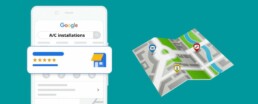
Include important HVAC keywords: 3 Reasons
When HVAC business owners respond to reviews, they should include keywords that are important to their business for several reasons.
1. Supercharge your SEO. Including relevant keywords in responses can help to improve the business’s search engine optimization (SEO). Google algorithms crawl through reviews, and business owners can strategically include relevant keywords in their responses. This can help to increase the visibility of the business in search results, especially for local searches.
2. Stand Out in a Crowded Marketplace. Including keywords in review responses can help to emphasize the business’s core values and services.For example, if the business specializes in air conditioning repair, including keywords like “AC repair” and “cooling system” in review responses can help to reinforce the business’s expertise and services to potential customers who may be searching for these keywords.
3. A Professional Touch. Including keywords in review responses can also help to show the business’s personality and professionalism. Responses to reviews are a chance for the business owner to showcase their communication skills and dedication to customer satisfaction. Including relevant keywords in the response shows that the business owner understands the needs and expectations of their customers and is committed to meeting them.
PRO TIP: When including keywords in review responses, HVAC business owners should ensure that they are used naturally and not stuffed in. Overuse of keywords can actually harm the business’s SEO and make the response seem unprofessional.

In conclusion, including keywords in review responses is a smart strategy that HVAC business owners should utilize to improve their business’s SEO, emphasize their core values and services, and showcase their professionalism.
Responding to reviews in a personalized manner that includes relevant keywords shows that the business owner is committed to customer satisfaction and can help to attract new customers who are searching for those keywords.
Therefore, HVAC business owners should make it a priority to respond to all reviews and ensure that they include relevant keywords in their responses.
2. HVAC Reviews Responses - Examples
Here are some examples of how HVAC business owners can include relevant keywords in their review responses:
Positive review response:
“Thank you for taking the time to share your positive experience with our HVAC services. We take pride in providing high-quality air conditioning repair, and we’re thrilled to hear that you were satisfied with our work. If you ever need any further assistance with your cooling system, don’t hesitate to reach out to us!”
Keywords: HVAC services, air conditioning repair, cooling system
Negative review response:
“We’re sorry to hear that you had a negative experience with our team. At our HVAC business, customer satisfaction is our top priority, and we apologize that we fell short in meeting your expectations. We would like to offer you a discount on your next air conditioning repair service to make it up to you. Please give us a call to discuss further.”
Keywords: HVAC business, customer satisfaction, air conditioning repair
Neutral review response
“Thank you for your review of our HVAC services. We’re glad to hear that you found our team professional and courteous. At our business, we strive to provide exceptional service to all of our customers, and we appreciate your feedback. If you ever need any HVAC maintenance or repair services in the future, we would be happy to assist you.”
Keywords: HVAC services, exceptional service, HVAC maintenance, repair services
Conclusion
Overall, by including relevant keywords in their review responses, HVAC business owners can improve their SEO, highlight their expertise and services, and showcase their commitment to customer satisfaction.
Additionally, offering financing options, warranties, and maintenance plans can help customers see the long-term benefits of investing in high-quality HVAC services. By following these strategies, HVAC business owners can overcome price shoppers and build a loyal customer base that values their expertise and is willing to pay for the quality services they provide.
Get more website traffic & leads with our proven approach to digital sales and marketing.
Get more website traffic & leads with our proven approach to digital sales and marketing.
Get more website traffic & leads with our proven approach to digital sales and marketing.
Get more website traffic & leads with our proven approach to digital sales and marketing.
8 Ways HVAC Business Owners Can Handle Price Shoppers
8 Ways HVAC Business Owners Can Handle Price Shoppers
(and Get More Actual Business!)
8 Ways HVAC Business Owners Can Handle Price Shoppers
(and Get More Actual Business!)
In today’s highly competitive HVAC industry, price shoppers can pose a significant challenge to business owners. These are potential customers who prioritize cost above all else when selecting a service provider, often at the expense of quality, expertise, and reliability.
While it’s tempting to lower prices to win these customers over, doing so can hurt your bottom line and undervalue your services. As a result, it’s important for HVAC business owners to have a clear strategy in place to overcome price shoppers and communicate the value of their services effectively, especially when it comes to your most profitable installation services.
In this article, we’ll explore some effective tactics that you can use to attract and retain customers who prioritize quality over cost.
Try out these 8 Way to Overcome HVAC price shoppers:
- Overcoming HVAC Price Shoppers – The Basics
- Create the “Expectation” at your Website of Onsite Visits as a First Step
- Focus on the Complexity of HVAC Systems
- Focus on the “Benefits” and Eliminating Unexpected Issues
- Increase Onsite Visit Success
- Offer Financing Options to Overcome HVAC Price Shopping
- Use Scripts to Overcome HVAC Price Shoppers
- Price Shoppers – Seven Scripts for HVAC Business Owners
1. Overcoming HVAC Price Shoppers -
The Basics
a. Focus on value:
Instead of just focusing on price, emphasize the value that your services provide to customers. This can include highlighting your expertise, experience, and quality of work. By focusing on the value that your services offer, you can differentiate yourself from competitors and justify higher prices.
b. Build relationships:
Building strong relationships with customers can help to establish trust and loyalty, which can make them less likely to shop around for the lowest price.
Take the time to listen to your customers, understand their needs, and provide personalized solutions. This can help to establish a strong reputation and encourage repeat business.
c. Offer packages:
Offer packages that bundle several services together at a discounted rate. This can help to create a sense of value for customers and encourage them to choose your business over competitors who may offer lower prices for individual services.
d. Use marketing and branding effectively:
Use marketing and branding strategies to establish your business as a trusted, professional, and high-quality provider of HVAC services. This can help to create a strong brand image and make customers more willing to pay premium prices for your services.
e. Provide exceptional customer service:
Provide exceptional customer service, from the initial contact through to completion of the job. This can help to create a positive customer experience and encourage customers to return for future business.
f. Encourage onsite visits before giving HVAC quotes:
Offering a free onsite evaluation can be a great way to encourage potential customers to schedule a visit. This allows you to assess the job and provide an accurate quote or estimate, while also showing the customer that you are committed to providing quality service.
We’ll go into more detail about this critical point below, including scripts you can use.
PRO TIP: While some services have standard pricing that you can give over the phone, more complex and typically more profitable services — like a new AC purchase and installation — are the services you should insist require an onsite visit.

By starting with implementing these basic strategies, HVAC business owners can develop habits that become part of a routine to overcome price shoppers…and establish your business as a trusted, valuable provider of HVAC services.
2. Create the "Expectation" at your Website of Onsite Visits as a First Step
An HVAC business owner’s website can be an effective tool to prime prospective customers into seeing the value of onsite visits prior to providing quotes. Here are some strategies that you can implement on your website:
a. Emphasize the importance of onsite visits:
On your website, make sure to emphasize the importance of onsite visits when providing accurate quotes for HVAC services.
Provide information on the benefits of having a professional visit the home to assess the system and provide a personalized quote.
b. Provide educational resources:
Use your website to provide educational resources, such as blog posts, videos, and FAQs, that explain the importance of onsite visits and what customers can expect during a visit.
This can help customers understand the value of the service and make them more likely to request an onsite visit.
PRO TIP: Priming the customer is a marketing strategy that involves preparing a customer to think about a product or service in a particular way, with the goal of influencing their decision-making process. By exposing customers to certain information, messages, or experiences (like an onsite visit prior to a quote), you can “prime” them to be more receptive to this and more likely to book an onsite visit.
c. Offer online scheduling:
Make it easy for customers to schedule an onsite visit directly from your website. Offer online scheduling tools that allow customers to choose a convenient time and date for the visit, which can help make the process more efficient and convenient.
d. Showcase positive customer reviews:
Highlight positive customer reviews that discuss the value of onsite visits and the quality of your services. This is easy to set up with the type of questions you can ask customers when requesting reviews.
This can help build trust and credibility with prospective customers, and show them the benefits of choosing your business for their HVAC needs.
e. Personalize the quote process:
Provide a personalized quote process that requires onsite visits. For example, you can offer a form on your website where customers can provide information about their system and request an onsite visit for a personalized quote.
This can help reinforce the importance of the service and demonstrate the value of working with a professional.
By implementing these strategies on your website, you can help prime prospective customers into seeing the value of onsite visits prior to providing quotes.
By emphasizing the importance of the service, providing educational resources, offering online scheduling, showcasing positive customer reviews, and personalizing the quote process, you can demonstrate the benefits of working with a professional and build trust and credibility with prospective customers.
3. Focus on the Complexity of HVAC Systems
One way HVAC business owners can encourage onsite visits before giving quotes or estimates is by explaining the importance of an onsite visit. Again, for installations of furnaces, heat pumps, AC’s and Boilers, this is a must.
HVAC systems can be complex and require a thorough evaluation to determine the cause of a problem and the best solution. Throw out a few technical terms and even the most thorough online searcher will likely go silent.
By explaining the importance of an onsite visit to potential customers, business owners can highlight the value of their services and build trust with customers.

During the explanation, you can emphasize that without an onsite visit, they may miss important details that could impact the final cost of the job.
For example, there may be issues with the system’s ductwork or ventilation that are not visible from the outside, or the system may require repairs or upgrades beyond what the customer initially thought. By conducting an onsite visit, you can provide a comprehensive evaluation of the system and identify any potential issues that need to be addressed.
Additionally, an onsite visit allows you to discuss options with the customer and provide recommendations that are specific to their system and needs. This can help the customer make an informed decision about their HVAC system and feel confident that they are getting the best service possible.
PRO TIP: Customers are very insecure about large ticket purchases like a Heat Pump or new Furnace and they rarely come armed knowing exactly what they need. Assure them you’ll explain your recommendations in a non-technical way and that you’re not there to push one solution over another.
In summary, by explaining the importance of onsite visits, you can show potential customers that you are committed to providing quality service and solutions that are tailored to their specific needs. This can help build trust and confidence with customers, which can ultimately lead to more business and positive reviews.
4. Focus on the “Benefits” and Eliminating Unexpected Issues

Frame the onsite visit in terms of benefits. Again, one major benefit of an onsite visit is the opportunity for the HVAC technician to inspect the system or equipment in person. This allows the HVAC experts to identify any issues or potential problems that may not be visible from the outside or in photos.
By inspecting the system or equipment in person, you can provide a more accurate quote or estimate for the job. You can also discuss the findings with the customer and explain the various options available for repairing or upgrading the system.
This can help the customer make an informed decision about their HVAC system and feel confident that they are getting the best service possible.
The average homeowner spends over $9,000 a year on home services, including maintenance and repairs.
The Globe and Mail
Another benefit of an onsite visit is the opportunity to discuss options with the customer. By being able to see the system or equipment in person, as the experts, you can provide recommendations that are specific to the customer’s needs and system. This can help the customer make a decision that is right for them and their budget.
Finally, an onsite visit can help build trust and confidence with potential customers. By taking the time to inspect the system or equipment in person and discuss options with the customer, your team can show that they are committed to providing quality service and solutions. This can help build a positive reputation for the business and lead to more referrals and repeat business.
5. Increase Onsite Visit Success
a. Provide clear instructions for scheduling an onsite visit:
Provide clear instructions for scheduling an onsite visit, such as phone numbers, email addresses, or a scheduling tool at your website. Respond promptly to requests for onsite visits to show that you value the customer’s time.
As noted in this article here, customers may not always choose the first company they contact, but they’ll often go with the one that responds first.
b. Share customer testimonials:
Sharing testimonials from previous customers who benefited from an onsite visit can help build credibility and encourage potential customers to schedule a visit.
c. Follow up after the onsite visit:
Following up with the customer after an onsite visit can help keep your business top of mind and provide an opportunity to answer any additional questions or concerns.
PRO TIP: Establishing trust with your customers on the “easy stuff” can positively impact their confidence in you for major decisions like an HVAC purchase and installation. Unfortunately, some contractors have a reputation for disorganization, which can undo prior efforts to gain customer trust.
Overall, HVAC business owners can encourage onsite visits before giving quotes or estimates by explaining the importance and benefits of onsite visits, offering a free onsite evaluation, providing clear instructions for scheduling, sharing customer testimonials, and following up after the visit.
6. Offer Financing Options to Overcome HVAC Price Shopping
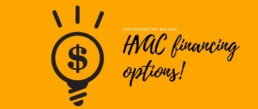
Offering financing options is one of the most effective ways that HVAC business owners can overcome price shoppers and appeal to a wider range of customers.
By providing affordable financing solutions, you can help customers who may not have the immediate funds to pay for a new heating or cooling system upfront, but who still want to invest in the comfort and energy efficiency of their home.
Here are some key ways that offering financing can help you overcome price shoppers:
q. Provide flexibility and affordability:
By offering financing options, you can provide flexibility and affordability to customers who may be hesitant to invest in a new HVAC system due to the upfront cost. Financing allows customers to spread out the cost over time, making it more manageable and accessible to their budget.
b. Increase purchasing power:
Financing also allows customers to increase their purchasing power, as they may be able to afford a higher-end HVAC system or more advanced features that they would otherwise not be able to purchase outright.
This can help differentiate your business from competitors who may not offer financing, and attract customers who are looking for the best value for their money.
c. Build long-term customer relationships:
Build long-term customer relationships: Offering financing options can also help you build long-term relationships with customers.
By providing a valuable service that helps them meet their needs and achieve their goals, you can create loyal customers who will return to your business for future needs and recommend your services to their friends and family.
d. Stand out from the competition:
In a highly competitive industry like HVAC, offering financing can help you stand out from the competition and differentiate your business. By providing an added value to customers that competitors may not offer, you can increase your market share and grow your business over time.
In summary, offering financing options is a powerful tool that HVAC business owners can use to overcome price shoppers and appeal to a wider range of customers. By providing flexibility, affordability, and increased purchasing power, you can build long-term relationships with customers, stand out from the competition, and grow your business over time.
7. Use Scripts to Overcome HVAC Price Shoppers
Using scripts is a common practice in many industries, including sales and customer service, as they can provide a useful starting point for conversations with customers. However, it’s important to remember that scripts should not be rigidly adhered to, especially if they make you sound robotic or insincere.
Instead, it’s crucial to speak in your own voice, in a way that feels comfortable and natural to you. This means incorporating your own personality and tone into your interactions with customers, as well as adapting to their individual needs and preferences.
By speaking in your own voice, you can build trust and credibility with your customers, as they will be able to sense your authenticity and genuine interest in helping them. This can be especially important in the HVAC industry, where customers are often seeking advice and guidance on complex technical issues.
If you’re able to explain these concepts in a way that is clear, concise, and relatable, you’re more likely to win their business and build a long-term relationship.
PRO TIP: Even experienced sales professionals can become overwhelmed by difficult customers. However, following a script framework allows for flexibility and adaptability in handling unexpected situations.
Of course, this doesn’t mean that you should abandon all structure and preparation when speaking with customers. It’s still important to have a basic framework for your conversations, as well as key talking points that you want to cover.
However, by using these tools as a guide rather than a strict script, you can ensure that you’re able to adapt to the unique needs and preferences of each customer, and provide a more personalized and effective service overall.
In summary, while scripts can be a useful starting point for conversations with customers, it’s important to speak in your own voice and find a balance between structure and personalization. By doing so, you can build strong relationships with your customers, win their trust, and differentiate yourself from the competition.
8. Price Shoppers - Seven Scripts for HVAC Business Owners
Here are some scripts that HVAC business owners can use to help overcome price shoppers:
a. Highlighting Value:
When speaking with customers, HVAC business owners can use a script that emphasizes the value of their services. For example:
“Thank you for considering our company for your HVAC needs. We understand that you have many options when it comes to HVAC services, but what sets us apart is the value that we provide.
Our technicians are highly trained and experienced, and we use only the highest quality equipment and materials. This ensures that the job is done right the first time and that your HVAC system will operate at peak efficiency for years to come.
The investment in our services may be higher than some other companies, but the value that you receive in return is well worth it.”

b. Building Relationships:
HVAC business owners can use a script that focuses on building relationships with customers. For example:
“We appreciate the opportunity to earn your business. Our goal is to establish a long-term relationship with you, and to provide you with the highest quality HVAC services at a fair price.
One of the things that set us apart is that we take the time to listen to your needs and provide personalized solutions, and we always stand behind our work.
We believe that building strong relationships with our customers is key to our success, and we look forward to serving you for many years to come.”
c. Offering packages:
HVAC business owners can use a script that promotes packages of services. For example:
“We have a special package deal right now that includes a high-efficiency furnace and air conditioner for one low price. It’s a great way to save money and ensure that your home is comfortable no matter the weather.
Our package includes a top-of-the-line furnace with a variable-speed blower and a high-efficiency air conditioner with a SEER rating of 16 or higher. We’ll also provide professional installation and a one-year warranty on all parts and labor. And the best part is, we’re offering it all at a discounted package price.”
And when they ask about the package price:
“The cost of the package will depend on the specific size and needs of your home, but we can provide a free estimate for you after an onsite visit. And with our financing options, we make it easy to get the comfort you need without breaking the bank. Plus, you’ll enjoy energy savings and improved comfort for years to come.”
d. Providing exceptional customer service:
HVAC business owners can use a script that emphasizes the importance of exceptional customer service. For example:
“At our company, we understand that customer service is just as important as the quality of our work. That’s why we strive to provide exceptional customer service from the moment you contact us until the job is complete.
Our technicians will arrive on time, treat your home with respect, and provide you with a detailed explanation of the work that needs to be done. We believe that a positive customer experience is key to building strong relationships.”
e. Explain the importance of onsite visits:
“Hello, and thank you for considering our HVAC services. I just wanted to take a moment to explain the importance of an onsite visit before we give a quote or estimate.
HVAC systems can be complex, and there may be issues that are not visible from the outside.
By conducting an onsite visit, we can inspect the system or equipment in person, identify any potential issues, and provide a more accurate quote or estimate.
I can’t tell you how many times we discover [general example of serious issue that has occurred] that dramatically affected the installation process…and as a result, the quote reflected that.
On the other hand, we sometimes come as the 2nd or 3rd quote and have found some serious savings for our customers based on what their actual needs were.
Again, without an onsite visit, we may miss important details that could impact the final cost of the job. So, we strongly recommend an onsite visit to ensure that we can provide the best possible service for your needs.”
e. Explain the importance of onsite visits:
“Hello, and thank you for considering our HVAC services. I just wanted to take a moment to explain the importance of an onsite visit before we give a quote or estimate.
HVAC systems can be complex, and there may be issues that are not visible from the outside.
By conducting an onsite visit, we can inspect the system or equipment in person, identify any potential issues, and provide a more accurate quote or estimate.
I can’t tell you how many times we discover [general example of serious issue that has occurred] that dramatically affected the installation process…and as a result, the quote reflected that.
On the other hand, we sometimes come as the 2nd or 3rd quote and have found some serious savings for our customers based on what their actual needs were.
Again, without an onsite visit, we may miss important details that could impact the final cost of the job. So, we strongly recommend an onsite visit to ensure that we can provide the best possible service for your needs.”
Conclusion:
In conclusion, HVAC business owners can successfully overcome price shoppers by focusing on building trust, emphasizing the value of their services, and differentiating themselves from their competitors.
By developing a strong reputation for quality workmanship, offering excellent customer service, and providing competitive pricing, business owners can demonstrate their commitment to delivering exceptional value to their customers.
Additionally, offering financing options, warranties, and maintenance plans can help customers see the long-term benefits of investing in high-quality HVAC services. By following these strategies, HVAC business owners can overcome price shoppers and build a loyal customer base that values their expertise and is willing to pay for the quality services they provide.
Get more website traffic & leads with our proven approach to digital sales and marketing.
Get more website traffic & leads with our proven approach to digital sales and marketing.
Get more website traffic & leads with our proven approach to digital sales and marketing.
Get more website traffic & leads with our proven approach to digital sales and marketing.
15 Proven HVAC Marketing Strategies to Attract and Retain Customers
(and Make 2023 Your Best Year Ever!)
Want to bring in new customers, stand out from the competition, and boost your revenue?
Then it’s time to get smart with your HVAC marketing strategies. Check out this guide for fifteen effective ways to promote your business, complete with tips and tricks for building brand awareness and attracting more customers.
Try out these HVAC Marketing ideas:
- Boost Your HVAC Business with Online Credibility and Trust
- Maximize Your HVAC Marketing Budget by Retaining More Customers
- The Power of Responsiveness: How Quick Responses Can Help Convert HVAC Leads into Clients
- Increasing Your HVAC Business's Local Rankings: (Accurate Citations and SEO Strategies)
- Your HVAC Marketing Superpower: Reviews, Review Management, and Transparency
- Leveraging Social Media for HVAC Commercial Success
- Pay-Per-Click Advertising and Local Service Ads that Drive HVAC Leads
- Yes, Facebook Ads Can Drive Valuable HVAC Leads
- Use your Google Business Profile to Attract New HVAC Clients
- Leverage the Power of Video Marketing to Attract and Retain HVAC Customers
- Why Live Chat is a Must-Have in Your HVAC Marketing Strategy
- The Power of SEO HVAC Marketing
- Turn HVAC Price Shoppers into Customers
- Increasing Revenue from Existing Customers with HVAC Email Marketing
- Incentivizing Customer Referrals: Tips and Ideas for a Successful Referral Program
1. Boost Your HVAC Business with Online Credibility and Trust
Trust is a crucial factor in any business, but it’s especially important in the home service industry where customers are inviting contractors into their personal spaces. As an HVAC business, it’s essential to establish trust with potential customers from the start…which, more often than not, starts with a new visitor coming to your website.
So what are they going to see when they get to your site? And how can you keep them there longer…and taking the action you want them to — like clicking to call or filling out a quote request?
One way to do this is by creating a top-quality website design that provides essential information about your business. This includes your service area and contact information, clear and focused service pages with a clear call-to-action (like “Book an Appointment”), as well as any relevant experience you may have.
In addition to providing basic information about your business, you can also use your website to gain the trust of potential customers by offering helpful resources and information. For example, you can create informational blog posts that help customers solve common HVAC problems. This not only demonstrates your expertise in the field, but it also shows that you’re willing to go the extra mile to help your customers.
PRO TIP: While providing enough information to establish trust, don’t overwhelm your website visitors with too much information or too much clutter — especially not on your important service pages. Confusing your customers will send them clicking away to your competitors.
It’s important to remember that in this digital age, customers go online to research businesses before deciding where to take their business. And that there’s a “standard” visitors expect when they get to your site.
That’s why your website is crucial for making a good first impression — it serves as your virtual storefront for prospects. A whopping 75% of people judge the credibility of a company based on the design of its website (we wrote about that in detail at our post here).

Make sure your site is visually appealing and easy to navigate, and be sure to optimize it for mobile devices. With more and more people accessing the internet on their phones — and the fact that Google mainly uses the mobile version of a site’s content (crawled with the smartphone agent) for indexing and ranking) — it’s essential that your website is mobile-friendly to ensure a positive user experience.
In summary, building customer trust as an HVAC business requires a combination of providing essential information about your business, offering helpful resources, and creating a top-quality website design that is mobile-friendly. By following these basic steps, you can start to establish credibility and trust with potential customers and set the foundation for a successful marketing presence online.
2. Maximize Your HVAC Marketing Budget by Retaining More Customers
Retaining your existing customers should be a top priority for any business, and that includes HVAC companies. According to Harvard Business Review, the cost of acquiring a new customer is significantly higher than what you would spend on retaining an existing one – anywhere from 5 to 25 times more. That’s why it’s essential to focus on keeping your existing clients happy and satisfied with your services.
One way to do this is by using HVAC marketing strategies to identify any problems or issues that may be causing dissatisfaction among your current clients, or troubleshooting in advance for issues they may not be aware exist in their home. This could involve collecting information that can be helpful for your client and your bottom line.
For example, if your technicians install an AC and note that the age of the furnace in the house is getting to that “end-of-life stage,” you could schedule a follow up with your customers at an appropriate time to offer your “client rate” for a new furnace installation during your traditionally slower times. By gathering this information, you can tailor your marketing efforts to better meet the needs of your customers.
Cost of acquiring a new customer is 5—25x more than retaining an existing one.
Harvard Business Review
Good customer service is also essential when it comes to retaining existing clients. Homeowners are typically pretty protective and sensitive about the work that goes on in their homes.
Make sure you’re responsive to their needs and willing to go the extra mile to address any issues they may have. Building strong, long-lasting relationships with your customers is crucial to the success of your business, so do what it takes to manage these highly beneficial relationships. Don’t get me wrong, they don’t need a therapist — they just want to know that you care.
In summary, good customer service is essential for retaining existing clients and building strong, long-lasting relationships with them. This can be achieved by:
- Providing multiple ways for customers to contact you
- Responding promptly and professionally to inquiries and complaints
- Proactively addressing potential issues
- Being flexible and willing to adapt to the needs of your customers
- Not underestimating the value of the "emotional" side of customer service
- Educating your customers about the products and services
- Providing the "right" options for their needs
By following these guidelines, you can ensure that your customers are satisfied, continue to support your business, and actively refer their friends and family.
3. The Power of Responsiveness: How Quick Responses Can Help Convert HVAC Leads into Clients
As noted earlier, it’s essential to make it easy for potential customers to contact you on your company website. This means including your contact information in a prominent location and offering options like webchat or a mobile app for convenient communication. If a prospective customer is interested in your HVAC services, they should be able to easily reach out to you and get a quick response.

To ensure you’re providing excellent customer service and maximizing your chances of converting HVAC leads into clients, it’s crucial to have a fast response time.
PRO TIP: Customers may not always choose the first company they contact, but they’ll often go with the one that responds first. By being responsive and accessible, you can increase your chances of winning their business.
In summary, make it easy for prospective customers to contact you, and be sure to respond promptly to inquiries — especially when customers are in the buying mode, like asking for an installation quote. By doing so, you’ll improve your chances of converting leads into clients and establish a reputation for excellent customer service.
4. Increasing Your HVAC Business's Local Rankings: (Accurate Citations and SEO Strategies)
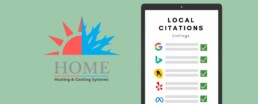
When it comes to finding local services companies for HVAC installation, maintenance, or repair, potential customers turn to search engines like Google and Bing. And because most of these searches are location-specific, the results almost always show Local Maps results.
This means that the higher your company ranks in local listings, the more likely you are to be chosen by prospective clients. So, how do you ensure that your website ranks highly in these listings?
One way to improve your rankings is by fixing any incorrect or inconsistent citations that may be affecting your website. Citations are business listings or local directories that can be found on search engines or local listings websites. If these citations contain incorrect information or are inconsistent with your business’s name or location, it can negatively impact your ranking.
PRO TIP: It’s a good idea to list your business on directories that are specific to your industry. These types of directories usually have a better chance of ranking well for keywords related to your business, which can lead to more leads and increased visibility.
Local citations make up 10.82% of local pack ranking factors and 8.41% of localized organic ranking factors.
Moz
A super complete citation is called a NAP, which stands for phone number, address, and company name. Even if the mention of your business doesn’t include a link, it’s still considered a local citation. For example:
- Company name
- Company name and address.
- Company name and website.
- Company name and phone number.
- Company name, address, and phone number.
- Company name, address, and website.
- Company name, address, phone number, and website.
5. Your HVAC Marketing Superpower: Reviews, Review Management, and Transparency
Obtaining online reviews is a crucial advertising strategy for HVAC businesses because it helps to build trust with potential customers. In today’s digital age, people rely on online recommendations to make purchasing decisions, and this is especially true for local services companies.
And reviews will significantly impact the performance of your local search rankings in the Local Maps.
According to a Podium survey, 88% of people decide whether to do business with a local company based on online recommendations. This means that having positive reviews can significantly impact your company’s success.

So, how can you get more online reviews for your HVAC business?
One way is to ask your customers to review your business on various platforms, such as Google or social media. You can do this in person when you’ve completed a job or through a follow-up email or card with review URLs. It’s essential to be ethical when requesting reviews and to avoid incentivizing customers for positive feedback.
It’s also crucial to respond promptly to any reviews you receive, whether they are positive or negative. This shows that you value your customers’ feedback and are willing to address any concerns they may have. By actively seeking and responding to online reviews, you can build trust with potential customers and improve your chances of attracting new business.
PRO TIP: Don’t just say “Thanks for reviewing us,” when responding to reviews. Here’s a better response example that incorporates commercially valuable keywords: “Thank you for sharing your feedback with us! We’re glad to hear that your Air Conditioning installation went according to plan – and that the kids, dogs and all of you are set up for a summer of comfort. Your recommendation is much appreciated!”
In addition to asking for reviews directly from your customers, you can also consider using review management software to help manage your online reputation. This type of software allows you to track your reviews across multiple platforms and respond to them in one place, making it easier to manage your online presence.
Another way to build trust with potential customers is by being transparent about your business practices. This means being upfront about your pricing, providing clear information about your services, and being honest about any potential delays or issues that may arise (like when unpredictable supply chains push back installation dates). By being transparent, you show that you value your customers’ trust and are willing to be open and honest with them.
Overall, building trust with potential customers is crucial for the success of any HVAC business. By actively seeking and responding to online reviews, using review management software, and being transparent about your business practices, you can establish a reputation for excellent service and increase your chances of attracting new clients.
6. Leveraging Social Media for HVAC Commercial Success
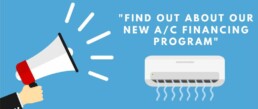
Social media is an essential part of any HVAC marketing strategy because it helps to improve your online visibility and reach potential customers. Search engines use social signals as a key ranking factor when determining where to place your website in search results, so having a professional social media page can significantly impact your website’s ranking.
Once you’ve created a social media page for your HVAC business, you can use it to share links to your blog content, videos, and photos of projects you’ve completed. This helps to showcase your expertise and capabilities and gives potential customers a sense of what it’s like to work with your company.
Here are a few ideas to get you started:
- Share before-and-after videos that show the transformation of an HVAC repair job.
- Share air conditioning tips and tricks to help your followers troubleshoot and maintain their own systems.
- Keep your followers up to date on the latest HVAC trends and new technology by sharing interesting news articles or industry insights.
- Share client reviews and testimonials to showcase your company's excellent service.
- Promote special deals or promotions you're offering to encourage followers to take advantage of your services.
By experimenting with different types of content and paying attention to what your audience engages with the most, you can develop a social media strategy that effectively keeps your followers interested and engaged.
Overall, having a strong social media presence is an important part of any HVAC marketing strategy. By using social media to share your expertise, connect with customers, and engage in marketing efforts, you can improve your online visibility and reach more potential clients.
7. Pay-Per-Click Advertising and Local Service Ads that Drive HVAC Leads
Using pay-per-click (PPC) advertising, also known as search engine marketing (SEM), can be an effective way to drive traffic and leads to your HVAC website.
PPC advertisements show up in relevant search engine searches and in the news feeds of social media platforms for the people you’ve identified as your target customers. When executed well, PPC advertising can provide a return on investment that is multiple times the amount you spent initially.

One platform for PPC advertising is Google Ads (formerly known as Google Adwords). This platform allows you to create targeted ads for your HVAC company and can be an excellent way to generate new customers.
It’s important to remember that HVAC leads can be hard to come by and can be costly, so it’s essential to make sure you’re generating them from qualified potential customers in your local area. This way, your team will be able to respond quickly to their needs when they contact you.
To ensure that you’re maximizing the effectiveness of your PPC efforts, it’s a good idea to employ geotargeted strategies to limit your service area. This way, you can avoid wasting valuable marketing budget on targeting customers who are too far away for you to service quickly.
Another option to consider is Local Service Ads (sometimes known as Google Guaranteed). These ads can help fill in the gaps in your HVAC marketing strategy while you’re waiting for your SEO efforts to take effect.
PRO TIP: Google Ads will automate recommendations to go “broad” and fully automate. This is a recipe for overspending for most local HVAC companies. You need to manage spending with tightly controlled campaigns that limit AI bidding strategies.
Google Ads is a particularly useful platform because it allows users to customize their messages to appeal more effectively to specific groups within different geographic areas based on data points like keyword usage history and demographic traits.
In summary, PPC advertising can be an effective way to drive traffic and quality leads to your HVAC company. In experienced hands, PPC advertising is a fantastic tool for scaling up and growing your HVAC company.
8. Yes, Facebook Ads Can Drive Valuable HVAC Leads
Facebook ads can be a valuable tool for HVAC companies looking to increase their visibility and reach potential customers.
With Facebook’s targeting options, HVAC companies can target their ads to specific groups of people based on factors such as location, age, income and interests, making it an effective way to reach homeowners and businesses in need of HVAC services.
The ability to track the performance of Facebook ads in real-time allows HVAC companies to see how many people are seeing their ads, how many are clicking on them, and how much they are spending on the campaign. This information can be used to optimize the campaign and make adjustments to improve its performance.
Facebook offers a variety of ad formats that businesses can use to reach their target audience. Here are some of the most popular formats:
- Single Image Ads: These are the most basic ad format, which includes a single image and a short amount of text.
- Video Ads: These ads feature a video that can be up to 120 minutes long. They can be used to showcase products, services, or company culture.
- Carousel Ads: These ads allow businesses to display multiple images or videos in a single ad, which can be swiped through by the user. They’re great for showcasing different products or services or telling a story.
- Slideshow Ads: These are similar to video ads, but they use a series of images to create a video-like experience. They’re a good option for businesses that don’t have the resources to create a professional video.
- Collection Ads: These ads are designed for businesses that want to showcase multiple products in a single ad. They feature a cover image or video, and users can click through to see more products.
- Instant Experience Ads: These ads are designed to be fast-loading and engaging, and they allow users to interact with the ad without leaving Facebook.
- Lead Generation Ads: These ads allow businesses to collect contact information from potential customers directly within the ad.
- Messenger Ads: These ads are delivered directly to a user’s Facebook Messenger inbox, and they allow businesses to communicate with potential customers directly through the platform.
These are the main ad formats offered by Facebook, but the platform is constantly evolving and updating its ad options, so it’s worth checking back from time to time to see if there are any new formats available.
The variety of ad formats allows HVAC companies to choose the format that best suits their message and goals, whether it’s promoting their services, running a seasonal promotion or building brand awareness.

Facebook lead forms are effective because they allow businesses to easily collect contact information from potential customers. They are quick and easy to fill out, and can be completed directly within the Facebook platform.
Additionally, the lead forms are mobile-friendly, which means that they look great and are easy to use on both desktop and mobile devices. This is important since most of the Facebook users access the platform through mobile devices.
PRO TIP: Facebook Ads that have specific offers work best in the HVAC and home services market. Try using Lead forms — they tend to convert better and they allow you to easily automate follow up.
If you’re not getting any business from your Facebook ads, then it’s likely that you’re not using the platform effectively. There could be a number of reasons why your ads aren’t performing well. Here are a few potential issues to consider:
- Targeting: The most important aspect of any Facebook ad campaign is targeting the right audience. If you’re not reaching the right people, your ads won’t be effective, no matter how well-designed they are. Make sure you’re using the targeting options available on the platform to reach the right people based on factors such as location, age, gender, interests, and behaviors.
- Ad design: The design of your ads is also important. Make sure your ads are visually appealing and clearly communicate your message. Use images and videos that are high-quality and relevant to your product or service.
- Ad copy: The text of your ads should be clear and compelling. Make sure it’s easy to read, and use action-oriented language to encourage people to click on your ad.
- Budget: Make sure you’re allocating your budget effectively. If you’re not spending enough on your ads, they won’t be seen by enough people to be effective. Additionally, monitor your campaigns’ performance regularly, and adjust your budget accordingly.
Facebook Ads are an excellent part of a solid HVAC marketing plan, but they require an in-depth understanding of messaging, offer shaping and campaign execution.
9. Use your Google Business Profile to Attract New HVAC Clients

Google My Business is a free tool that allows businesses to manage their online presence across Google, including Search and Maps. Google basically decides how high your business shows up in local search results by looking at a few things:
- First, it checks if your Google My Business listing is a good match for what someone’s searching for.
- Next, it looks at how far your business is from the person searching or the location they put in their search.
- Lastly, it checks how popular your business is based on stuff like how many websites link to it, how many reviews it has, what people are saying in those reviews, and how well optimized your website is.
PRO TIP: Use Google Posts to share updates, promotions, and events with your customers. And be sure to stay on top of your Profile — as of this writing, the default automations can create some wacky product and service listings that you’ll need to revise.
Many local businesses haven’t claimed their free GBP account, so it’s essential to take advantage of this opportunity to improve your online presence and reach more potential customers. It’s easy…just do the following:
- Complete all elements of your profile
- Verify your location(s)
- Add real images and videos of your business
- Include keywords in your profile
- Encourage and answer reviews and questions
- Keep your business information up to date
- Add your products and services
By leveraging the power of GBP and optimizing your profile, you can stand out in the crowded HVAC market and attract new clients. Overall, Google My Business can be a powerful marketing tool for HVAC businesses looking to improve their online presence and reach more customers.
10. Leverage the Power of Video Marketing to Attract and Retain HVAC Customers
As an HVAC professional, you know better than anyone just how many homeowners don’t know how to change their HVAC filter or perform other basic maintenance tasks.
When these homeowners need to learn something new, what do they do? According to a survey of U.S. viewers, 86% say they regularly turn to YouTube to learn new things. This is no surprise, considering that YouTube is the world’s second-largest search engine.
Not only is video becoming the preferred way for many people to consume information, but it also has the potential to significantly increase conversion rates.
The key to successful video marketing is creating the right kind of videos and distributing them on platforms that your target audience uses, such as social media, your website, and email.
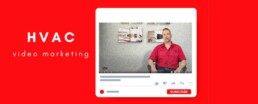
When creating videos for your HVAC business, it’s important to keep a few things in mind:
- First, try to limit your videos to two minutes or less to increase the likelihood of viewership. No one wants to watch a long, boring video, especially when they’re just trying to learn something quickly.
- Second, consider placing your videos on popular service pages of your website. This will make it easier for customers to find them when they’re looking for information about your services.
You can also incorporate videos into your blog content to provide valuable information to your customers and increase engagement. This can be especially helpful for homeowners who prefer to watch a video rather than read a long article.
Marketers who incorporate video into their campaigns experience 34% higher conversion rates.
Aberdeen Group
In addition to uploading your videos to your website, don’t forget to upload them to your YouTube channel as well. This will give you an additional platform to reach potential customers and increase your visibility.
Video is also a powerful tool on social media. By posting videos on platforms like Facebook and Instagram, you can showcase your business and engage with your customers in a more interactive way. Just be sure to use hashtags and tag relevant accounts to increase the reach of your videos.
In summary, video marketing can be a powerful tool for HVAC businesses. By creating short, informative videos and distributing them on your website, YouTube, and social media platforms, you can reach a wider audience and increase your conversion rates.
11. Why Live Chat is a Must-Have in Your HVAC Marketing Strategy
It’s becoming increasingly important for businesses to offer live chat options on their websites, as a significant percentage of consumers expect it. According to recent studies, 41% of consumers expect live chat on desktop websites and 50% expect it on mobile websites.
If your HVAC business doesn’t currently offer website chat services, now is the time to consider adding them. Not only do they provide near-instant responses to customer questions, but they also leverage artificial intelligence to chat with website visitors without requiring additional resources from your customer service team.
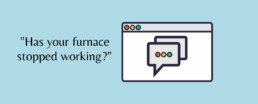
In addition to providing a convenient and efficient way to communicate with customers, website chat services can also increase website conversion rates by an average of 2%.
PRO TIP: Use chat scripts, but keep them flexible. Scripts provide team members with guidelines to stay on track and deliver accurate information. So you don’t sound too scripted, encourage team members to personalize them and improvise as they gain experience.
Overall, website chat services are a valuable addition to any HVAC marketing plan. They provide convenience and efficiency for customers while also increasing conversion rates and driving more leads to your business. If you’re not currently offering live chat options on your website, it’s time to consider adding them.
12. The Power of SEO HVAC Marketing

HVAC SEO is the process of optimizing your HVAC business website in order to rank higher in organic search results and attract more clicks from users. When someone searches for HVAC-related terms on Google, they will see a combination of paid advertisements, organic search results, and featured snippets.
Organic search results are ranked based on algorithms that consider a variety of ranking factors, making SEO an important aspect of internet marketing for HVAC businesses…after all, PPC costs are not going to go down in the future.
One key element of HVAC SEO is the use of strategic keywords. Keywords are the terms and phrases that people use when searching for a specific product or service. By understanding what potential customers are searching for, you can incorporate target keywords into your HVAC website design and content.
Many homeowners search online to find local professionals, so it’s essential to optimize your website and marketing efforts for local keywords.
For example, if you own a company in Toronto, some HVAC keywords might include:
- “Toronto HVAC company”
- “HVAC in Toronto”
- “Toronto furnace installation”
- “Toronto AC repair”
PRO TIP: SEO takes time and it is a significant investment…so, consider using PPC (paid campaigns) to ensure you know what keywords convert into paying customers. That way, you won’t waste that investment on search keywords you believed would turn into customers…but actually don’t.
In addition to using commercially valuable keywords, it’s also essential to have high-quality content on your HVAC website related to your service categories. Quality content helps to establish your authority in the industry and can improve your search engine rankings.
In addition to targeting general and local keywords, it’s also a good idea to focus on low-hanging fruit keywords as part of your HVAC SEO strategy. These are keywords that have low-to-medium search volume and low keyword difficulty, making them easier to rank for.
13. Turn HVAC Price Shoppers into Customers
It’s a common misconception among home improvement contractors that price shoppers are not serious about purchasing their services. However, this belief can end up costing contractors a significant amount of lost revenue.
When a potential customer calls to discuss services, it’s important to approach the conversation as a sales opportunity. This means applying common sales techniques, such as:
- understanding the customer’s needs
- building value and rapport
- addressing any concerns.
Contractors can build value by highlighting their technician expertise, hiring process, service warranties, industry experience, customer reviews, and accreditations.
In reality, around 32% of homeowners ask about pricing on the initial call. If a contractor automatically rejects a third of homeowners seeking their services, they may be missing out on potential business.
It’s also important to provide a comforting reason for why you can’t give them pricing over the phone. Without seeing the issue in person or knowing more about the home and seeing the set up firsthand, it’s impossible to provide accurate pricing.
Ultimately, the goal is to transition from the pricing discussion to setting up an appointment for someone to come and take a look at the issue. By following these tips and avoiding the common pitfalls of discussing pricing on the initial call, contractors can increase their chances of booking appointments and winning business.
14. Increasing Revenue from Existing Customers with HVAC Email Marketing

Email marketing can be an effective way to increase revenue from existing HVAC customers. By promoting special offers, service upgrades, and new services through email, you can remind your customers about your business and build stronger relationships with them.
Here are a few steps to help you get started with email marketing to your existing clients:
- Plan your content: While it’s important to occasionally include sales messages in your emails, you should focus most of your content on educating and informing your readers about HVAC systems. This will help keep your clients subscribed and engaged, and will demonstrate your expertise.
- Offer value: In order for your clients to read your emails, you need to provide them with something valuable. This could be a blog post with air conditioning usage tips, a discount on your services, or some other type of value-added content.
- Write a strong subject line: The subject line is the first thing your clients see when they receive your email, so it’s important to make it interesting and compelling.
PRO TIP: Avoid using generic subject lines like “Sales promotion” or “New services,” and instead try to be more specific and engaging. For example, “Save 20% on a tankless water heater install when you book today!” is much more likely to get your clients to open your email.
Automating email marketing can help you save time and effort, communicate with your subscribers consistently and personalize your message, and measure, test and optimize the effectiveness of your campaigns.
With automation, you can scale your email marketing efforts to reach a large number of subscribers without having to manually send each email.
By following these steps, you can effectively use email marketing to promote your services to existing clients and increase revenue.
15. Incentivizing Customer Referrals: Tips and Ideas for a Successful Referral Program

A customer referral program is a great way to leverage the power of word-of-mouth marketing and encourage your loyal customers to spread the word about your business. Referral programs can be an effective and cost-effective way to attract new customers, as long as you offer the right incentives to your current and referred customers.
Here are a few examples of referral incentives you could consider:
- Offer a discount on your services as a reward for successful referrals. For example, you could offer a $50 discount on the next A/C maintenance visit for referees, or a similar discount for furnace maintenance in the summer.
- Offer a cash or credit reward for closed sales resulting from referrals. For example, you could offer $100 in cash or credit per closed sale.
Run a contest where referring customers are entered into a drawing for a grand prize, such as a $200 Visa gift card. This can be a fun and engaging way to encourage referrals and reward your most loyal customers.
There are many other creative ways you can incentivize referrals, so be sure to consider what would be most appealing to your customers. By implementing a customer referral program, you can tap into the power of word-of-mouth marketing and grow your business.
Conclusion:
If you want to get more leads for your HVAC business, online marketing is a great way to do it. It’s not only effective and cost-efficient, but you can measure your success too. But it’s not just going to happen on its own. The HVAC companies that are rocking it have a plan and stick to it consistently. The difference between just getting by and really growing your HVAC business is having an effective online marketing system that helps you grow and adapts to keep growing with you.
Get more website traffic & leads with our proven approach to digital sales and marketing.
Get more website traffic & leads with our proven approach to digital sales and marketing.
Get more website traffic & leads with our proven approach to digital sales and marketing.
Get more website traffic & leads with our proven approach to digital sales and marketing.
Facebook vs. Google Ads – which one is right for your business?
Facebook vs. Google Ads – which one is right for your business?
Online Marketing Level: Beginner Read
Facebook Ads have long been a popular choice for independent and small to medium-sized businesses as they provide a reasonably affordable opportunity for advertising products and services online. But as more and more companies are now advertising with Facebook Ads, the competition has increased and so has the cost per click.
Maybe you are also struggling with the continuously increasing costs of your ads on Facebook? And thinking about giving Google Ads a try? Or are you wondering if you should combine Google Ads with Facebook Ads?
In this article we’ll explore:
• the differences between ad formats on Google and Facebook.
• which network is right for your business.
• what you should keep in mind for Google Ads campaigns to be effective and cost effective.
Advertising formats on Google
Both advertising networks, Facebook and Google, offer a multitude of ad formats. In Google Ads you can serve text ads. But there is much more that you can do with it. For example, online stores have the option of displaying their products in Google Search, including image and price. In addition, you can advertise with banners and video ads on other websites.
In this post, we’ll focus on comparing Facebook Ads and Text Ads on Google Search. These are 2 of the most common and effective advertising channels.
Google Text Ads vs. Facebook Ads
Which are better for your business – Facebook or Google Ads? Well, there is no black and white answer to this question. First, let’s take a look at the purpose of each platform. How do we use Facebook or Google?
Google is a search engine. People use Google to find information, answers or even specific products or services. They have a defined search intent, meaning they have a specific need and are actively looking for a solution.
Ads in Google Search contain text and links but no images. Here is an example of a Google Text Ad:

Facebook is a network. Facebook is all about meeting and exchanging information. We log into Facebook to see what our friends are up to, look at holiday pictures, or share an opinion. People using Facebook typically are in what we call “leisure mode,” they seek distraction and entertainment.
Facebook Ads contain text, links, pictures and videos. Here is an example of a Facebook Ad:
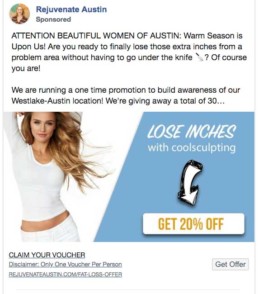
Create Awareness on Facebook
Facebook is ideal to reach those who have a need, but who are not actively searching for anything. It’s a great way to draw attention to unknown solutions, new offers or visually attractive products.
The combination of image and text (or video and text) allows you to address users on different perceptual channels.
Your ad needs to draw attention and generate interest. When scrolling through the newsfeed, the content of your ad needs to address a reader’s need that they may not have been aware of until now. And it needs to stand out visually and interrupt the user.
Example:
Mike is a teacher who works on his feet all day long. He’s bothered by his feet but it’s not to the point where he’s going to Google to look for a treatment option. On Facebook he stumbles across an add promoting a free foot assessment from a physiotherapist in his area. He never considered his feet might be the source of his sore back, but the ad speaks to his issue, so he clicks on the ad.
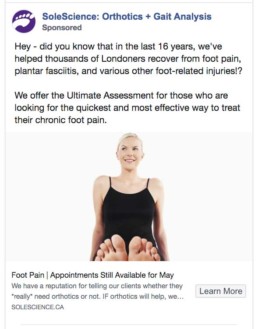
What’s special about Facebook Ads: You target your ad to personal interests and traits, such as age and gender, of those who should see your ad. That’s why it’s so important to know your target audience as well as possible when you run Facebook Ads. You need to learn all about them: what they like, what their needs are, what’s challenging for them and so on.
Offer Solutions with Google Ads
Ads in Google Search will only reach those who are actively looking for a particular solution or product. Your ads will appear in Google search when someone looks for exactly what you are offering.
Google Ads campaigns are therefore based on the search intent and the behavior of users on Google. This means that in order to promote your product or service with Google your offer must be known.
Example:
Katja has an issue with her hot water tank in her some. She searches on Google for “hot water tank repair”. She will then be shown ads by various plumbing providers serving Google Ads.
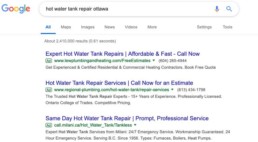
Special feature of Google Ads: Google Ads are always based on keywords. So the key here is to create a list of relevant keywords surrounding the products and services that you are offering.
For Google Ads you don’t need to define a target audience. They are based on a list of thematically grouped keywords and ads with matching texts.
While the ads are based on keyword lists and search behavior, it is still an advantage if you know your target audience well. Your ad is not the only one that appears. It’s very likely that your competitors advertise with the same keywords on Google. Remember, the ads appear on top of each other grouped together or at the bottom of the page.
The better you know the needs of your audience, the easier it is to create ad copy that resonates with your target audience.
4 Helpful Factors for Your Decision
So how do you decide which type of ad works best for your business?
Whether you choose Google or Facebook ads depends primarily on how well known your product or service is and how your audience is behaving. Additional important factors are costs and objectives.
Let’s take a closer look at all four points:
1. Is there any Search for your Product or Service in Google?
That’s the key question! If you can clearly answer it with “No,” then Google Ads make less sense. If you are unsure, then you can easily find the search volume with a free tool like kwfinder. Suppose you want to know if and how often “Physiotherapy” is googled in Edmonton Canada. You enter your keyword, loation and language:

Take into account that your favourite client may use different words or colloquial language instead of the usual technical terminology. You can ignore uppercase and lowercase letters, as they aren’t relevant to Google.
After clicking on “Find keywords” you will get the result on a new page:
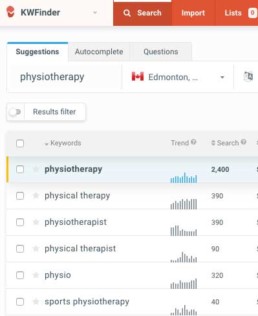
Tip: Log in to the kwfinder once with your email address. This will allow you to run 5 queries daily. You can sign up for the paid option if you need to run more queries within 24 hours.
If there is no search volume then the tool displays the value “N / A” instead of a number. No search volume = no Google Ads.
What search volume do you need for a keyword list to make Google Ads worthwhile?
There is no rule for it. However, you can calculate it based on an expected click and conversion rate.
A good click-through rate (clicks to impressions ratio) on Google Ads across all industries is 5%. The average conversion rate is roughly 2%. Note, these vary widely by industry.
If you don’t achieve these rates, keep in mind that these are cold contacts. In addition, you always have to remember you’re competing for real estate on Google. Most people compare multiple quotes before they buy. It’s therefore hard to compare the click and conversion rates of Facebook and Google. The requirements are simply too different.
Again, the click and conversion rates for Google Ads can vary widely. Factors that influence these include competition, how well your campaigns are structured, your ad copy and the design of your landing pages.
The above values are approximations that should give you a rough ballpark of where you should aim. In industries with little competition, higher click through rates are possible.
Here are some basic examples of scenarios that affect click and conversion rates for Google Ads:
- The more appealing your ad text is, the higher your click-through rate will be.
- The more appropriate your keywords are for the ad text, the higher the click-through rate.
- The more competitors run ads, the lower the click-through rate.
- The more convincing your landing page, the higher the conversion rate.
- The more expensive your offer, the lower the conversion rate.
A reasonable and attainable goal for Google Ads is a click-through rate of 10%. Whether that pays off depends on what you offer, your conversion goal, and the cost per click. We’ll take a look at the cost factor in a bit, but let’s first look at another important aspect.
2. Is Your Desired Customer Actively Searching?
Suppose you know for certain that your product or service is being searched for on Google.
But are the searchers really your target group? You can only answer that question if you have already dealt in detail with your desired customer. Just because there is search volume on Google does not mean that it is automatically your target audience that is searching.
Example:
I have e.g. two very different target groups. Some are male and under 35. The other group is female and over 40. Both find me in different ways: the first group finds me almost exclusively through Google Search and the latter comes via Facebook. Both are very different in behavior, but they have the same need.
So looking at the search volume alone doesn’t provide enough information to make your decision. It’s also about the behavior of your target audience. Which leads us directly to the next point.
3. What Do You Want to Achieve?
- Advertise a freebie to build your newsletter mailing list.
- Generate traffic to attract more readers to your blog and increase awareness.
- Generate traffic to test different sales landing pages.
- Receive a registration for a paid course or webinar.
- Sale of offers or products.
At the very beginning we looked at the fact that the intention of the users on Facebook is different than on Google. This helps you to choose the right platform for your goals:
If you’re in the business of selling a specific product or service that has a high search volume, you’re likely to get a better conversion rate on Google. Because users that are looking on Google for a product or service already have a high purchase intent.
Users on Facebook often find ads annoying. They want to be entertained and distracted. There, you can best reach your goals with ads promoting information, such as: interesting blog articles or freebies.
In some cases, it may be useful to promote a blog post with Google Ads. For example, to announce a new blog that does not yet rank organically in Google. Or because there is a lot of search volume on certain topics that you blog about. But in most cases, Google Ads are simply too costly to use for generating traffic or building an email-list long term.
Which brings us to the last point, the cost of ads.
4. Which Platform has the Better Price-Performance Ratio?
A comparison of the platforms in terms of prices is difficult. It starts when looking at the cost for clicks:
- For Facebook, you have the option to pay for both ad impressions (CPM = cost per 1000 impressions) and clicks (CPC = cost per click). For Google text ads, you pay only for clicks.
- A click on Google is equivalent to a website visitor (or caller). On Facebook, a click can also be like-click or a click on a picture.
It’s best to compare at the conversion level. Try out both platforms and compare the cost per conversion.
Here’s a hint about Google Ads click cost: The estimated click prices can also be viewed in the kwfinder tool. This gives you a first impression. The actual cost-per-click may be quite different.
The actual cost-per-click depends on the competition, as well as the quality features of your Google ads:
- Quality Score: Google awards a quality score for each keyword in the account. The better each keyword matches the content of the landing page that the ads target, the higher the Quality Score. The higher the Quality Score, the lower the cost-per-click can be.
- Performance of the campaigns: campaigns that consistently achieve high quality with very good click through rates and conversion rates can count on low cost-per-clicks in the long term.
- Competition: If keywords are highly competitive, this can drive up the cost of clicks.
Conclusions
As you can see, there isn’t an easy answer. Whether you should run ads on Google or Facebook depends on a number of factors.
First, check the search volume on Google and think about what the goal of your campaign should be. That should help you decide. Incidentally, the two channels can work wonderfully together when combined. So you can, for example, place a campaign on Facebook. And when people go to the search engine to find you, they’ll find you through your Google ads.
Do you want to learn more about Google Ads? What you need to keep in mind to bring you exactly those website visitors that are looking for your offer?
Get more website traffic & leads with our proven approach to digital sales and marketing.
Get more website traffic & leads with our proven approach to digital sales and marketing.
Get more website traffic & leads with our proven approach to digital sales and marketing.
Get more website traffic & leads with our proven approach to digital sales and marketing.
Marketing to the Modern Insurance Customer
Marketing to the Modern Insurance Customer – here’s what’s hurting your agency
The age of the online insurance consumer has arrived! And with this, a record number of online searches, inquiries, and quotes that are generated 24 hours a day, 7 days a week.
The million dollar question – is your agency strategically positioned to capitalize on this market? Or, have you been slow to change, only taking half measures and doing the bare minimum?
These days, the right insurance marketing strategy will have prospects picking up the phone and calling your agency, filling out quote requests online, and sending their friends and family your way in numbers you would have thought impossible just a few short years ago.
3 out of 4 insurance purchases begin with an online search.
McKinsey
Satisfied customers, lower costs, higher growth
When consumers have an insurance itch that needs scratching, they turn to Google and their peers. In fact, a staggering 3 out of 4 insurance purchases begin with an online search.
What does that mean for digital savvy insurance agencies? A recent McKinsey research report tells us that smart insurers convert digital customers at six times the rate of their peers.
Wouldn’t it be nice if your agency had a digital marketing strategy that generates consistent leads and sales from these searches?
Let’s start with the biggest and most common mistakes to avoid:
Mistake #1 – a weak content strategy
Good content is what connects you to your customers online where they reside, it’s what drives them to trust you and ultimately leads them to an easier purchase decision. It’s also what separates you from your competitors – and allows you to really differentiate yourself from the other agencies in your marketplace.
There is too much ‘thin content’ in the insurance space. Content that adds very little value to readers…which, as a result, adds very little value to the bottom line for insurance agencies.
-
Insurance Sales Pages
On insurance sales pages, this often means pages that don’t provide enough relevant information for a consumer to make an informed decision. Or, alternatively, they may be presenting a great deal of information, but not what is “important to their customers.”
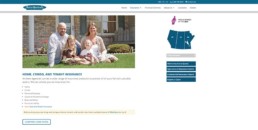
The thin content here makes it a challenge to connect with the customer. There is the overused ‘family hero shot’, no persuasive copy about the value of purchasing home insurance through their well-known and highly respected agency, and no breakdown or attempt to speak to the specific home, condo and tenant insurance customer. (Image source.)
Additionally, insurance sales pages routinely miss out on excellent opportunities to utilize known and tested psychological triggers that reduce friction, increase trust, and lead to purchases.
Matching Digital Content to Stages
So, you can identify the stages of the consumer lifecycle, but how do you relate them to content marketing?
As you’ve undoubtedly realized, you’ll need different online content for consumers at each stage of the lifecycle. After all, a customer who is just noticing your brand for the first time doesn’t want you hovering around, offering to answer any questions they have; they just want to explore.
By contrast, a customer who has educated him- or herself about your brand will be happy to have you available to answer additional questions about your product or service.
Your goal is to provide customers at each stage of the funnel with the content they need to lead them toward a purchase. Remember, great content also helps to keep customers interested in your business.
QUICK TIP
All of your online content should be written with a goal in mind and be appropriate for the stage of the consumer lifecycle it targets.
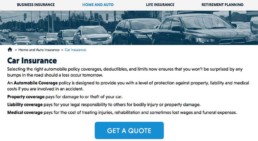
This auto insurance sales page is minimalist and factual, which can be very effective in some specific situations. But on a sales page that’s designed to encourage quote requests, it’s missing an emotional connection and trust signals on-the-page that you would expect to see from an 85 year old insurance agency. (Image source.)
Good content satisfies your prospects, both emotionally and intellectually. It answers questions ‘in ways consumers understand’ and it puts your insurance solution at the centre of your customer’s problem.
Good content also satisfies search engines like Google. Which in turn, means Google rewards your agency with prime real estate in the search engines.
-
Supporting Content Pages
Content that supports the sale, that answers detailed questions customers are searching for online that relate to your products are often missing entirely from agency websites.
When there is an effort to create this type of content by agencies, it typically underperforms due to a combination of technical shortcomings and a failure to adequately research the competitive landscape for this specific piece of content.
It’s not uncommon for us to see topics like “The Top 5 Spring Cleaning Tips”, or “Ways Your Business Can Avoid the Pain of Flu Season” or “How to Walk your Dog Safely in the Summer” throughout the insurance space.
Unfortunately, these types of content are not driven by keyword research and actual search appetites of insurance customers…so, they end up not ranking in Google search, not adding authority to insurance websites, and not supporting specific insurance business categories in a way that contributes to the bottom line.
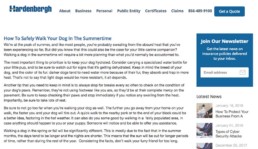
I think it’s fair to say that this content is not offering much to the reader or to the insurance agency itself. (Image source.)
Think strategically about your content. What do you want your content to do? What part of your business does it support? And can you make it the best piece of content on this topic and actually rank for it?
The consequences of a weak content strategy are clear:
Sales pages and all your supporting pages suffer – by failing to show up on the first page of Google search results and not getting those active buyers who are looking to purchase insurance; and by being unable to persuade customers to do what you would like them to do when they are actually at your site.
Mistake #2 – no page focus
Page focus starts with identifying what action you want visitors to take when they visit a specific page. This is commonly known as ‘the most wanted action.’
Everything you do on your page, from the copy, to the design, to the colour choices plays a role in a battle for your visitors attention. And that attention is limited. All the extra ‘noise’ and distraction on the page needs to be eliminated. A whopping 58% of users will skim pages if they’re constrained by time (and who isn’t these days).
Above all else, draw the reader’s attention to what matters most.
While this is a simple enough concept in principle, it can be an extremely challenging one to implement site wide. It takes skill, experience, and a willingness to test pages and iterate for ongoing improvements.
-
Homepages
For insurance websites, the homepage is often the least focused page out of necessity. If you’re selling a variety of personal lines (auto, home, life) and commercial/business lines it can feel like an almost impossible task to limit distraction and noise.
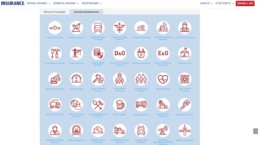
The ‘never ending page’ is all too common on the homepage. It can be especially challenging to remove things that you believe add value, even when that makes the page overwhelming. Removing elements and doing user-testing will help with this. (Image source.)
Hick’s Law states that the more stimuli (or choices) users face, the longer it will take them to make a decision. So when you have many options – from personal insurance to business, it’s necessary to group and categorize choice. This will enable users to find items from higher categories, as if they were looking under sections in a library.
Almost 75% of customers who attempted to purchase insurance online reported a myriad of problems.
Accenture
Avoid flooding with options, but bear in mind the balance between users’ time and comfort zones for handling options on a page. Guiding them to select between clear options that will get them somewhere quickly (such as your carefully designed home insurance page) will take the work out of the user experience and reward you both.
Insurance Sales Pages
For your sales page, it’s critical that you eliminate visual competition. If you have a sidebar with alternative or competing content like in the example below, user-testing will likely reveal that it’s pulling attention away from your main page…and hurting your conversions for that page.

While the branding of this insurance site is excellent, this particular sales page lacks needed focus. On this home insurance page, there are 5 different types of home insurance categories presented all at once. In addition, there are multiple sidebar boxes promoting Wedding Day protection, First Time Drivers and more. (Image source.)
If you have 4 blog posts at the bottom of the page because you’re worried the page needs to look longer, try it without those posts. Chances are high that you’ll get a lift in your on-page conversions.
If you have social share buttons next to your quote request like the site below, consider an alternative location. After all, you want your social channels like Facebook to support your business, not the other way around.

It’s become a design trend to place social share buttons near the entry point of websites, but for insurance sites this isn’t always ideal. There are optimal times for social sharing, like when a visitor has consumed one of your blog posts…but the act of social sharing should not compete with your ‘most wanted action’ – getting users to notice and click on your ‘Get a Quote’. (Image source.)
Mistake #3 – no landing pages
Online leads cost less than half as much as leads from any other marketing channel.
Hubspot
Once you’ve done all that hard work to get visitors to your website, the next big step is to convert them into leads and sales for your agency.
And that’s why landing pages today have become a secret weapon for many insurance agencies.
What is a landing page? In the most basic sense of the definition, landing pages are any pages that drive that first entry point into your website.
Your awesome landing pages matter because they can do two important things at once:
- They can make it easier for you to drive targeted/segmented organic search traffic to your website.
- They can make it easier for you to turn those visitors into leads and sales.
Why? Because well-researched and carefully crafted landing pages allow you to compete where you can actually get wins.
Let’s say your focus is on life insurance and it would be business-changing for your agency to rank on the first page of Google by getting visitors who search for “life insurance.” So yes, create an effective life insurance page and incorporate all the triggers necessary to make it deliver.
The problem with this term (which is often called a ‘head term’) is not the massive volume of visitors you would receive if you ranked on the first page, rather, it’s simply that State Farm, Geico, Progressive and Met Life occupy that important real estate.
I’m not saying don’t compete with those big players or don’t challenge them. But go to the open meadow, pick the low hanging fruit.
-
Focus Where You Can Win
When you segment your target a little, like say, for “life insurance for over 40” – you’ve got yourself a winnable opportunity.
And because this is more targeted traffic, it allows you to tailor your message to a specific type of customer (on this specific landing page, of course), to speak directly to them, to use the power of persuasion and the science of conversion to turn them into a loyal customer.
Online leads cost less than half as much as leads from any other marketing channel.
Hubspot
In the insurance space, landing pages are most often used in PPC advertising campaigns, but they are underutilized as a means of natural organic Google acquisition and conversion. And that’s where the gold is.
Landing pages allow you to be hyper-relevant to your customer – and that’s something customers have come to expect and demand. Furthermore, they offer endless opportunities to sharpen your marketing message, to test, and to learn in an unprecedented way about your different customers.
Mistake #4 – no reviews strategy
Many insurance agencies, despite having great relationships with many of their customers, do not have a built-in system or process for asking for reviews. As a result, this process of asking for reviews can often fall through the cracks, so to speak.
The end result is that all this goodwill that your agency has earned is not being put to use…to show potential customers what an amazing experience they had, and what a terrific agency you are to work with.
The fact that 70% of consumers will leave a review for a business when asked suggests that you should seriously consider making reviews requests a formal part of your on-boarding process.
The benefits of reviews are plentiful:
- It helps you with local search. All other things being equal, with more reviews, the better your placement in the local 3 pack maps section. That’s valuable real estate and a great place to be.
- When you use them properly on your sales pages, they’ll increase your conversions.
- Implement schema markup properly at your site and you’ll have stars showing up in your search results – which will make those search results stand out more like in the image below.
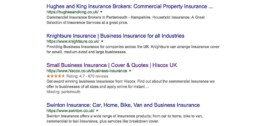
Reviews not only build trust at your website, they also enhance your listings in search results. Despite having the 3rd position here, it’s obvious which listing will receive the most clicks from visitors.
Customers expect reviews in the insurance space. After interviewing insurance customers for market research, reviews are regularly cited as a significant validator.
90% Of customers say buying decisions are influenced by online reviews
Marketing Land
This is an area where you can get a big win even if you have no other digital strategy in place. But focus on Google reviews – they have the most impact on your search results.
Reviews are such an important area for insurance agencies to focus on as part of their on-boarding process that we wrote a post about “How reviews help your business and how to respond to reviews” here and “How the right testimonials deliver customers” here.
Conclusions
In our experience, the four mistakes outlined above are some of the most repeated by insurance agencies.
Clearly, the insurance sector has changed and is adapting to the new digital reality. However, some insurance agencies have been reluctant to fully embrace a comprehensive digital strategy and are still relying on their in-force policies.
If history in other market niches tells insurance agencies anything, it is that they need to get ahead of the curve. Now is a great time to reprioritize your digital marketing and focus on building a strategy that will fuel your agency’s growth.
Get more website traffic & leads with our proven approach to digital sales and marketing.
Get more website traffic & leads with our proven approach to digital sales and marketing.
Get more website traffic & leads with our proven approach to digital sales and marketing.
Get more website traffic & leads with our proven approach to digital sales and marketing.
What is a Content Marketing Funnel?
What is a Content Marketing Funnel?
When you’re in business, it’s not enough look at the bottom line; you need to constantly think about ways to improve it. Growing your customer base or encouraging existing customers to take advantage of other products and services is the way to achieve your goal, and content marketing is a useful online tool to that end.
The focus of digital content marketing is to create and promote engaging content that drives awareness, enhances influence, and acquires customers. In other words, the content on your website should serve your business goal of attracting and retaining customers. To ensure that you’re on the right track, you’ll want to employ an approach called the content marketing funnel.
Content Marketing Funnel Definition
A content marketing funnel is an approach to online marketing that requires you to create different types of content for customers who are at different stages of the consumer lifecycle. It allows you to track brand familiarity and uses specially designed content to interest and convert shoppers into customers and to retain them.
You can picture the image in your mind: a funnel is wide at the top and narrows to allow you to easily pour liquid into a container. The various parts of the funnel are symbolic of customers at various stages of their buying lifecycle.

You can divide the funnel into three parts that reflect these stages:
- TOFU. TOFU stands for Top of Funnel, the funnel at its widest point. It represents the consumer awareness stage where potential customers are simply looking around for merchandise or services without having settled on a specific brand.
- MOFU. MOFU is the acronym for Middle of Funnel, the area where it tapers toward the spigot. It refers to the consideration stage of the lifecycle. Consumers are aware of your brand and exploring it in a bit more detail.
- BOFU. BOFU refers to Bottom of Funnel, the spigot where it narrows to allow for streaming into a container. It is the term for the purchase or trust stage, the point at which you aim to convert consumers to your brand.
Although there is no commonly accepted acronym for the next stage, let us suggest BEFU, or Beyond the Funnel. Visualize the container into which the funnel empties as representing customer retention; this, too, is an important part of the consumer lifecycle.
Matching Digital Content to Stages
So, you can identify the stages of the consumer lifecycle, but how do you relate them to content marketing?
As you’ve undoubtedly realized, you’ll need different online content for consumers at each stage of the lifecycle. After all, a customer who is just noticing your brand for the first time doesn’t want you hovering around, offering to answer any questions they have; they just want to explore.
By contrast, a customer who has educated him- or herself about your brand will be happy to have you available to answer additional questions about your product or service.
Your goal is to provide customers at each stage of the funnel with the content they need to lead them toward a purchase. Remember, great content also helps to keep customers interested in your business.
QUICK TIP
All of your online content should be written with a goal in mind and be appropriate for the stage of the consumer lifecycle it targets.
Content Marketing Examples
Let’s take a look at the types of content marketing you should consider for each part of the funnel – and beyond.

TOFU.
At the awareness stage of the lifecycle, your prospect has shown interest by arriving at your website, so you want to further their interest and generate brand awareness with interesting or educational content.
The key is to create copy that catches their attention and keeps them moving through the funnel, whether by discussing a problem that your business solves, reflecting on best practices or outlining common mistakes to avoid.
Content Marketing examples at this stage include, but aren’t limited to:
- Blog posts
- Guest blog posts
- Podcasts
- Infographics
- Videos
- Email newsletters
MOFU.
If a prospective customer sticks with you, going beyond the basics, they’ve reached the consideration stage; you’ve caught their interest and they are looking for reasons to choose your solution to their problem.
At the middle of the funnel, you want to offer examples of what your product or service can do and why it is a better choice than your competitors.
Content Marketing examples at this stage include, but aren’t limited to:
- Case studies
- Product videos
- Facts, such as the percentage improvement your product provided to customers
- Best practices or how-tos that mention your product
BOFU.
Once customers have reached the conversion stage, a direct pitch is appropriate. You want to nudge them – delicately, of course – to purchase your product or service.
At the bottom of the funnel, appropriate digital content marketing includes:
- A sales page
- Customer stories
- Classes
- Webinars
- Demos or free trials
- Testimonials or reviews
BEFU.
Once your customer has made a purchase, you want them to return. Retention deserves as much attention as sales; loyal customers are excellent sources of testimonials and referrals, as well as repeat business.
At this stage, you want to continue delivering content that keeps your brand top of mind. This requires that you get to know your customers and discover what is important to them.
Content Marketing examples that are appropriate for the retention stage includes:
- A customer-specific email newsletter
- How-tos from users
- Insider’s guides with tips on getting the most out of the product/service
- Special offers for new products or upgrades
Now that the content marketing funnel is no longer a mystery to you, you can unlock its potential!
Get more website traffic & leads with our proven approach to digital sales and marketing.
Get more website traffic & leads with our proven approach to digital sales and marketing.
Get more website traffic & leads with our proven approach to digital sales and marketing.
Get more website traffic & leads with our proven approach to digital sales and marketing.
What is a Local Citation?
What is a Local Citation?
In this digital day and age, most of us spend more time on the Internet than we could have imagined five or 10 years ago, whether we’re at our computers or on our smartphones. We do many of our business transactions online, too, whether it’s booking a flight and a hotel or ordering a birthday gift for a family member.
Business owners know that today’s competition doesn’t only come from the operation across the street, but from similar businesses in far-flung locations. Smart businesspeople also realize the value of a solid Internet presence, and one key to keeping your business front and centre is the local citation.
Local Citations Explained
A local citation is simply any online mention of your business. It’s usually some combination of the business name, address, phone number and website address.

You may see a local citation referred to as NAP (name, address, phone number), NAPW (name, address, phone number, website address) or UNAP (website URL, name, address, phone number). If a citation contains only one or two of these elements, it may be considered a partial citation.
Why Local Citations Matter
Local citations are important because they allow people to find your business online and help you increase your customer base.
They generally reside on third-party directory pages, called citation pages, created to aggregate businesses by type or by geographic area or both as a service to consumers.
Often, these pages have a review component (e.g., Yelp or Trip Advisor) that allows users to rate your business after they’ve been customers. These ratings provide potential users with the confidence that they’ll be getting good quality products and services – or not.
You may get more foot and online traffic with a positive review and an accurate citation; however, negative reviews and misleading citations can diminish your value in the eyes of potential customers.
Every local citation is valuable, because it helps push your business higher in the search engine rankings.
30% of mobile searches are related to a location. 28% of searches for something nearby result in a purchase.</3>
Google, 2016 Source
When people are randomly searching for Bakeries in Calgary or Shoe Stores in downtown Toronto, you want your business to pop up on that first page of listings, and numerous local citations add to the likelihood that it will be there.
Search engines scan the web to see how many mentions you receive, which affects your positioning in a search result; they also take into account the consistency of the local citations, the ratings you receive and the prestige/importance of the pages that cite your business.
When your local citations appear on many citation pages, it also helps to boost your visibility during online searches; these pages carry weight with search engines.

Types of Citation Pages
If you’re wondering about the types of citation pages you’ll find on the web, there are a few variations on the theme:
Major local business data platforms.
There are numerous important local business directory sites, including Google My Business, Acxiom, Localeze/Neustar, and Infogroup. In addition, there are major Social media sites that often include a review component, such as Yelp or Facebook.
Geo- or industry-specific platforms.
The websites for your local Chambers of Commerce and professional/industry associations are important homes for citation pages, since they draw many visitors.
Wider web platforms.
You’ll also find citations – although they may not be dedicated citation pages – on blogs, newspaper sites, government databases, applications and maps, for example.
Aggregated platforms.
Some citation pages derive automatically from data found on other sites; they are programmed to cull data for their own use. For example, Superpages uses the information found on Infogroup.
What’s the difference between structured and unstructured citations?
You’ll come across two different types of citations on citation pages:
- Structured. Structured listings are the type of listings you’ll find in a directory. They generally list the basics of your business: your NAPW.
- Unstructured. Unstructured listings are those you’ll find on sites that aren’t specifically directories, such as newspapers, blogs, etc. They often include opinions about your services or products.
Citation Value

Some citations are more valuable than others, because they are seen by more eyeballs. Undoubtedly, it’s more useful to have your citation appear prominently on a popular search engine than on a hobbyist’s blog that has limited readership. Consider these categories:
Top tier.
These search engines are the kings of citations; they receive data, rather than distribute it. Examples include Google and Bing.
Primary sources.
These sites collect and validate data from a variety of reliable sources, such as government directories and utilities; they then distribute their listings to hundreds of other sites. Examples include Infogroup, Localeze, Factual and Acxiom.
Tier 1.
These sites have high visibility with search engines and are trusted by people doing searches. They include Yelp, Facebook and the Yellowpages (YP), as well as local sites such as your city’s website or your professional organization’s site.
Tier 2.
Lesser known business sites with some prominence on search engines include Merchant Circle and HotFrog.
Tier 3.
Business directory sites that are more obscure, such as Local Database and Yellowise.
Tier 4.
Sites that are very obscure, including IGotBiz.com
Citation Consistency

Search engines such as Google and Bing collect data about businesses and the accuracy of the information allows the search engine to trust its validity and contribute to the strength of individual business rankings during searches.
QUICK TIP
Even though you may not have submitted your local citation directly to a directory or website, it’s up to you to make sure it is accurate and consistent with the information presented on other citation pages.
[divider style=”empty” margin_top=”0px” margin_bottom=”30px”]
If you want your business to appear near the top of a search, you’ll want your local citations to be accurate and consistent.
It is worth auditing your listings on top tier, primary, tier 1 and tier 2 sites to be sure that the information is accurate and consistent. Search all NAP variations; eliminate duplicates and correct those with mistakes.
At the end of your audit, you should have only one listing on each site and it should be accurate. Take control over how your business is presented online.
Creating a Great Citation

To create a citation that is informative, accurate and eye-catching, consider including the following information:
- NAPW. This should be obvious, but if not, confirm its existence.
- Business description. Even if you have one already, rewrite it to make it sing.
- High resolution photos. Pictures often do say 1,000 words, so make them good ones.
- Value proposition. Review this and revise it to make it unique.
- Locations. Include a list of the places your business operates.
Is your head spinning yet? Don’t fret. None of this is as daunting as it may seem at first glance, and the benefits of local citations far outweigh the work it takes to adjust them. You’ll be pleased with the increased exposure you receive.
Get more website traffic & leads with our proven approach to digital sales and marketing.
Get more website traffic & leads with our proven approach to digital sales and marketing.
Get more website traffic & leads with our proven approach to digital sales and marketing.
Get more website traffic & leads with our proven approach to digital sales and marketing.
How To Sell Insurance Online as a Broker in an Insuretech World
How To Sell Insurance Online as a Broker in an Insuretech World
Across the board in the insurance industry, from home and auto, to life and commercial, the pressure to innovate and to adapt is growing. By now, it’s no secret that technology and innovation are driving customer preferences and expectations about insurance.
The insurance market, once a staunch example of traditional business, is looking to make the most of these changing customer expectations and insurance purchasing behaviors (to the tune of 1 billion dollars in new insuretech investment in the 2nd quarter of this year alone).
So, what’s an insurance broker to do to stay competitive in this environment?
Online Quote Tools for Insurance are Standard

You need the right tools to compete digitally. That means an online quote option of some kind. Without an online quote option, you risk losing leads that are near to the purchase decision – to insurers who offer this convenience.
Online quote options are not cost-prohibitive, as there are plenty of 3rd party vendors that offer quote widgets or quote apps that are no longer technically challenging to implement into your website.
Insurance Customer Service Matters More Than Ever

There is a belief or assumption among brokers in markets of all size, that they own the “better customer service” model, and that the insuretechs of the world are simply dumbing down insurance and building their business on price alone.
While aggregators and comparison sites base their value proposition on price, this is not the case for most insurers in the online space. In fact, the B2C insuretechs of the world – that are doing it right – are beating brokers where it matters most, over the “entire customer experience.”
Where and how?
From the first point of contact, to sale, to post-transaction contact and follow-up, to reviews and referral requests, to real-time feedback. How?
- By having carefully crafted websites that speak in the language of the customer: a website that answers the most common questions purchasers have about their specific insurance options in a way that the average person can fully understand;
- By adding a level of transparency about coverage and claims that is uncommon in the insurance space;
- By also providing content that is not necessarily insurance-specific, but that is in the influence realm of insurers;
- By showing up more often in local search results;
- By building a review and referral system into their onboarding process.
The reality, is that most broker websites have a user experience that falls short of a great customer experience. In stark contrast with B2C insuretech, the majority of insurance brokers have not invested in a content marketing strategy that serves their customer base and their potential new clients. As a result, they miss even being “in the conversation” with new potential customers when they begin their online search.
Dominate Your Insurance Market Locally First, Then Grow Your Customer Radius

How does an insurance company located on the West coast eat up and capture more and more of your market share, when you’re located on the East coast and have a geographical advantage?
Smart insurance marketers are taking a “marketing locally” approach and tailoring their messaging and their sites to specific locales. Furthermore, they are investing heavily in boosting their trust and social proof by making customer reviews work for them in a way that local brokers are not.
What does that look like in the online environment and what impact does it have?
Online insurers who are marketing with a local focus, are showing up in organic search throughout the buying cycle for local terms, which increases trust, confidence and familiarity. Sweeten that with a sprinkling of local reviews and referrals and the impact is greatly enhanced.
In other words, an insurer 3,000 miles away has more of a local presence in a specific local market than the local office in the heart of the city.
So what can a local broker do?
First and foremost, dominate local search with an investment in the same strategies that are taking away your market share. But make investments and strategy work for you in places you can get wins. And then more wins. And when those wins pile up and you start to dominate your local marketing again, begin to expand your marketing radius a little at a time with the same approach.
Insurance Lead Generation isn’t an Either or Proposition

Here’s what traditional insurance marketing typically looks like: prospecting friends and family, attending networking events, hosting seminars and cold calling, mail campaigns (postcards and letters), referral incentive program giveaways, newspaper ads…even the purchasing of insurance leads.
Most insurance broker firms have a lopsided dependence on traditional marketing methods. Sometimes it’s due to the founding principal having a legacy built on this model. Other times, it’s simply because they don’t know where to start with their online marketing strategy, or what can move the needle in terms of writing new policies.
Have traditional insurance brokers come too late to the party?
Not yet. But the insurance market is adapting quickly. Delay means more online real estate will be staked out and claimed by those who act.
Acquire Insurance Customers Easier and Faster

There are efficiencies to digital insurance marketing that simply outperform traditional marketing. Especially in terms of reach.
That doesn’t mean the end of customer service. It actually means you can offer superior customer service by helping your customers make sense of their questions before they even reach out to contact you.
You can establish that trusted advisor relationship online. And help that mom at 9:30pm in the evening – after she has put her kids to bed and is looking for insurance options for her family on her tablet.
Insurance brokers who are successful at selling insurance online treat it like another lead generation method – fully aware of the fact that a relationship that starts online is still a relationship.
Ultimately, by fully embracing the online insurance environment and ecosystem, the brokers of tomorrow not only make the insurance transaction easier, faster and more efficient for the consumer – they also do that for their own lead generation and customer acquisition models.
Get more website traffic & leads with our proven approach to digital sales and marketing.
Get more website traffic & leads with our proven approach to digital sales and marketing.
Get more website traffic & leads with our proven approach to digital sales and marketing.
Get more website traffic & leads with our proven approach to digital sales and marketing.
4 Common PPC Mistakes Medical Practices Make
4 Common PPC Mistakes Medical Practices Make
Pay-per-click (PPC) advertising can be an effective and affordable way for a medical practice to attract new patients. But with so many elements to consider when launching a PPC ad campaign, it’s easy for inexperienced practice owners to make mistakes. Costly mistakes.
Here are four of the more common PPC advertising errors we run into with our healthcare clients.
Are you making any of them?
1. Not Monitoring your Campaigns Properly

If you can’t measure it, you can’t improve it. This is true in all areas of our lives and something most of us consider to be common sense. But as the old saying goes, “the problem with common sense is that it’s not so common.”
Conversion tracking is your PPC campaign’s oracle. Without conversion tracking in place, and running properly, you’ll be hard pressed to know what’s working, what needs fine-tuning, and what needs an overhaul.
Call-tracking not set up? Since most new patient enquiries come via the phone, it’s critically to know which campaigns are driving those calls. Call-tracking allows you to monitor and the keyword level. Granular, essential, and money-saving!
2. A Lack of Focus

If you don’t target your ads correctly, you’ll end up with the wrong visitors who just won’t generate revenue for your practice.
Match Type Misfire
Practices make this mistake frequently with keyword match types. Match types are often misunderstood and more often than not, keywords are too broad – which inevitably leads to ads showing up for irrelevant searches.
In the search below, you can see a typical example: in the 3rd position, therapy counselling is showing up for a popular physiotherapy search term. Obviously, when one is searching for a physiotherapist, the intent of the search query is to solve the problem of a physical ailment, not an emotional/mental health issue.
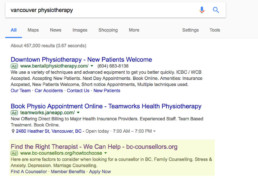
Adgroup Overload
Too many keywords in an adgroup is another place where practices bleed money. More is not always better, and this is especially true when you’re setting up your adgroups. Too many keywords per adgroup makes it almost impossible to “message match” with your copy and landing page.
Throw Everything at the Wall to See What Sticks
Because you’re not sure what’s really important to your potential patients (and you’re spending good money) – you include everything on your landing page. Every review that’s ever been written, every offer you have, anything and everything.
And this is confusing to the visitor that just clicked on your ad and now has to try to make sense of this mess. Nothing drives visitors away faster than confusion. Stick to one goal, one message, or one desired action per page.
3. Not Customizing Landing Pages to Specific Campaigns

This is widespread across a variety of industries, and something that drives PPC professionals into fits. But it is particularly common in healthcare.
Relevance matters. So, try to match your ad to a specific page as much as you can.
If your ad is aimed at women in the early stages of pregnancy, make sure there is a pregnant woman on your landing page…and/or, the same language (“Best San Diego OB-GYN”) that you use on your ad. Don’t send them to your general clinic page that lists the 10 other services you offer.
In other words, don’t create different ads with significantly different copy and send them to the same landing page.
Homepage Hang-Up
One of the biggest mistakes that AdWords beginners make is driving paid traffic to their homepage. This may be okay if this is a small part of a larger “awareness campaign,” but it’s generally a recipe for campaign underperformance.
Want to get new patients for a new procedure your clinic is offering? Create a specific campaign for that objective. Then, a specific corresponding landing page. A landing page dedicated to that objective is a huge part of maximizing the return you’ll see from your ad investment.
Keep in mind, visitors who click on ads and arrive on a landing page normally have a specific goal or intention in mind. So the most important thing you have to do, is instantly show relevance – by helping them achieve that goal.
Page Level Diagnosis
Here are some of the more obvious errors we see at the page level:
- Not aligning the CTA (call-to-action) and the contact form with the landing page copy.
- Too much information at the page.
- Asking too many different things of the visitor.
- Competing visual elements on the page.
- Poor copy.
4. Not Geo-targeting Effectively

Would someone drive 100 miles for your expertise? If you’re an orthopedic knee surgeon, that may be reasonable. A family dentist? Not likely, unless there are no other local options.
That’s not to say that you can’t add a reasonable radius. You can and it may be the best thing you can do depending on your specific location, the density of your area, and the number of similar providers in the area.
In fact, you can get very specific with your targeting, even by zip code – which can allow you to tailor messaging and speak to specific demographics.
Being mindful of how proximity influences our medical choices is something that needs to be considered and planned out at the campaign strategy level, as it has trickle down implications for much of your marketing campaigns.
PPC is not easy. If done wrong, you can burn through thousands of dollars. But if you target the right people, with the right expectations, and measure, test and iterate – you can make PPC an effective instrument in your medical marketing.








